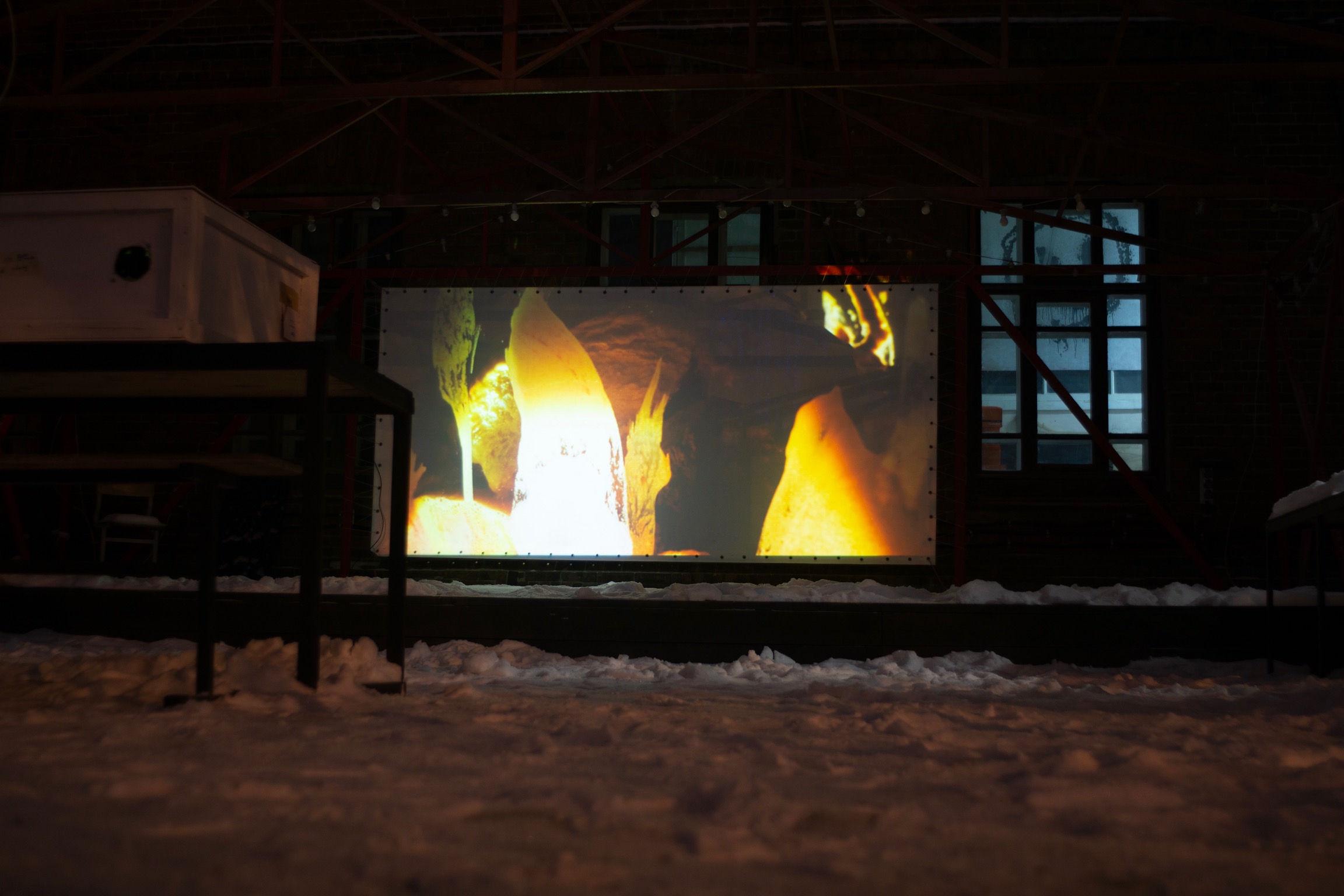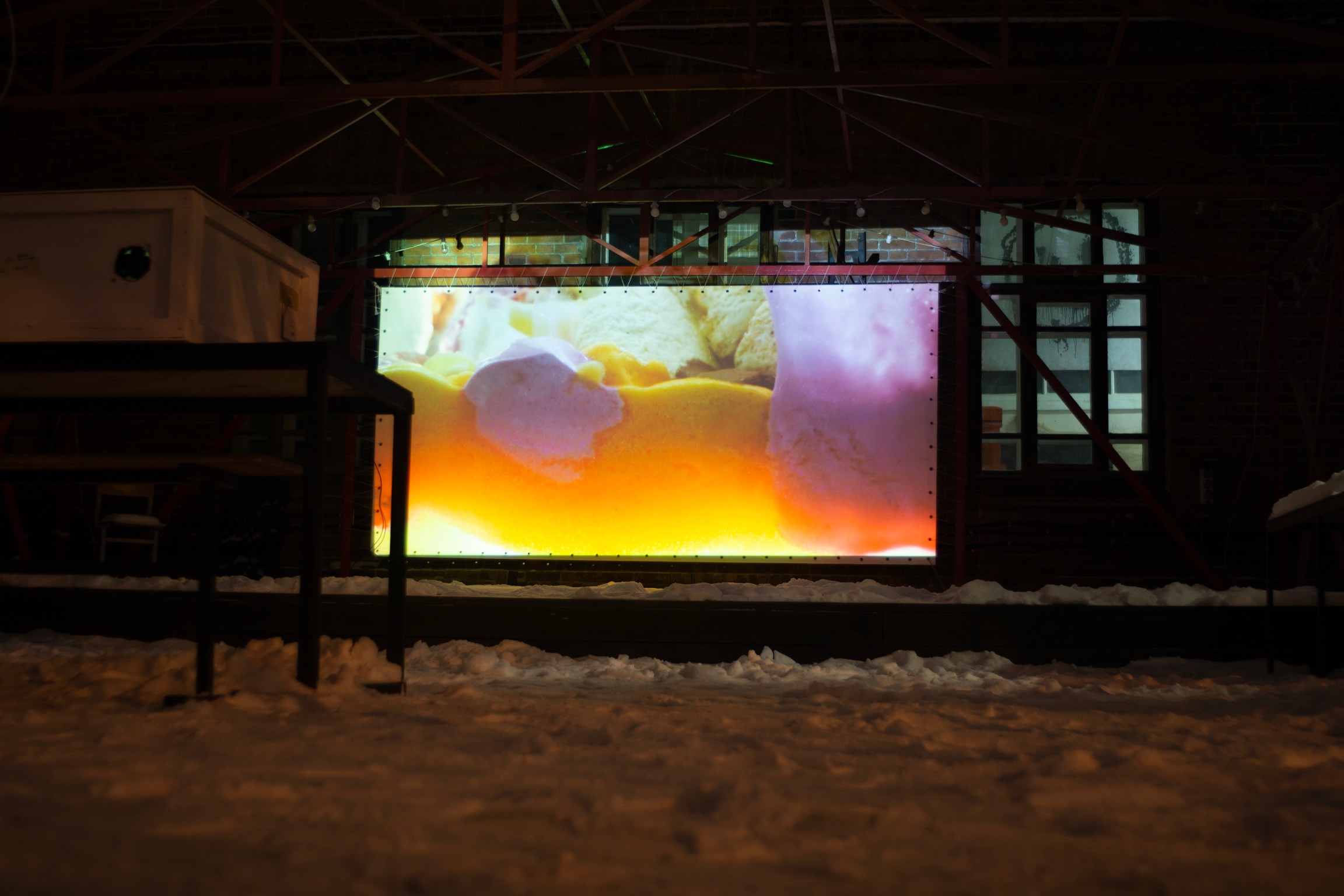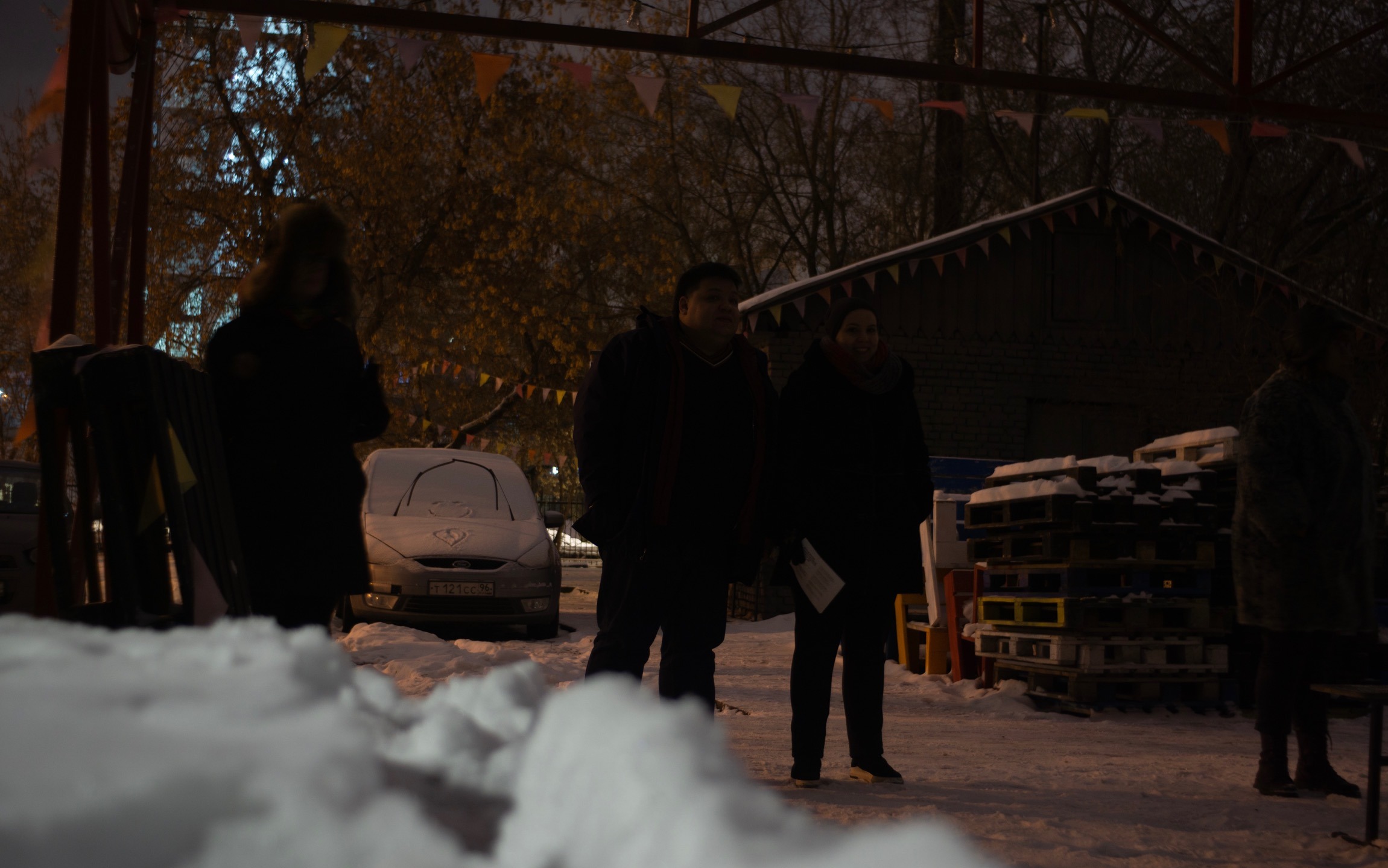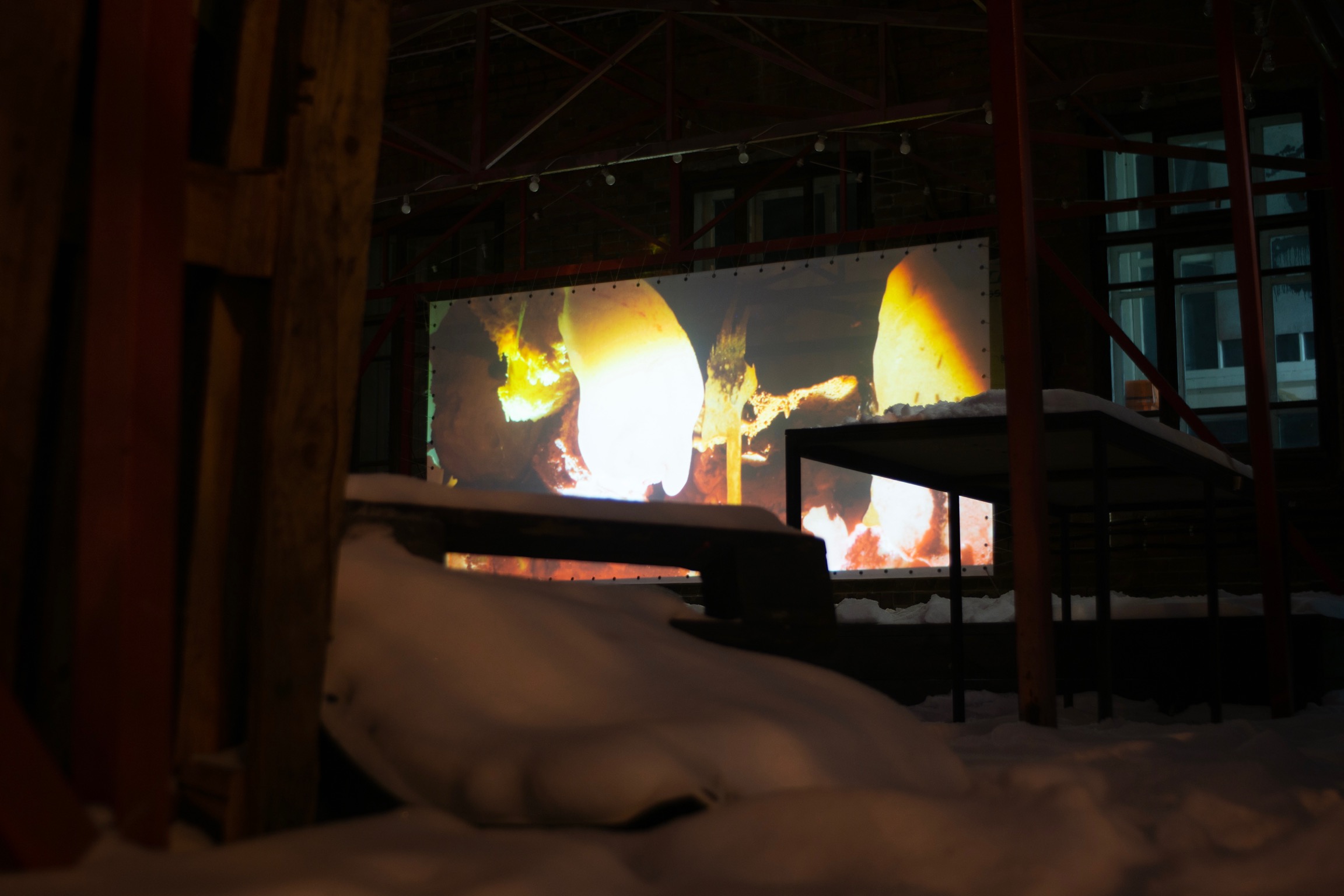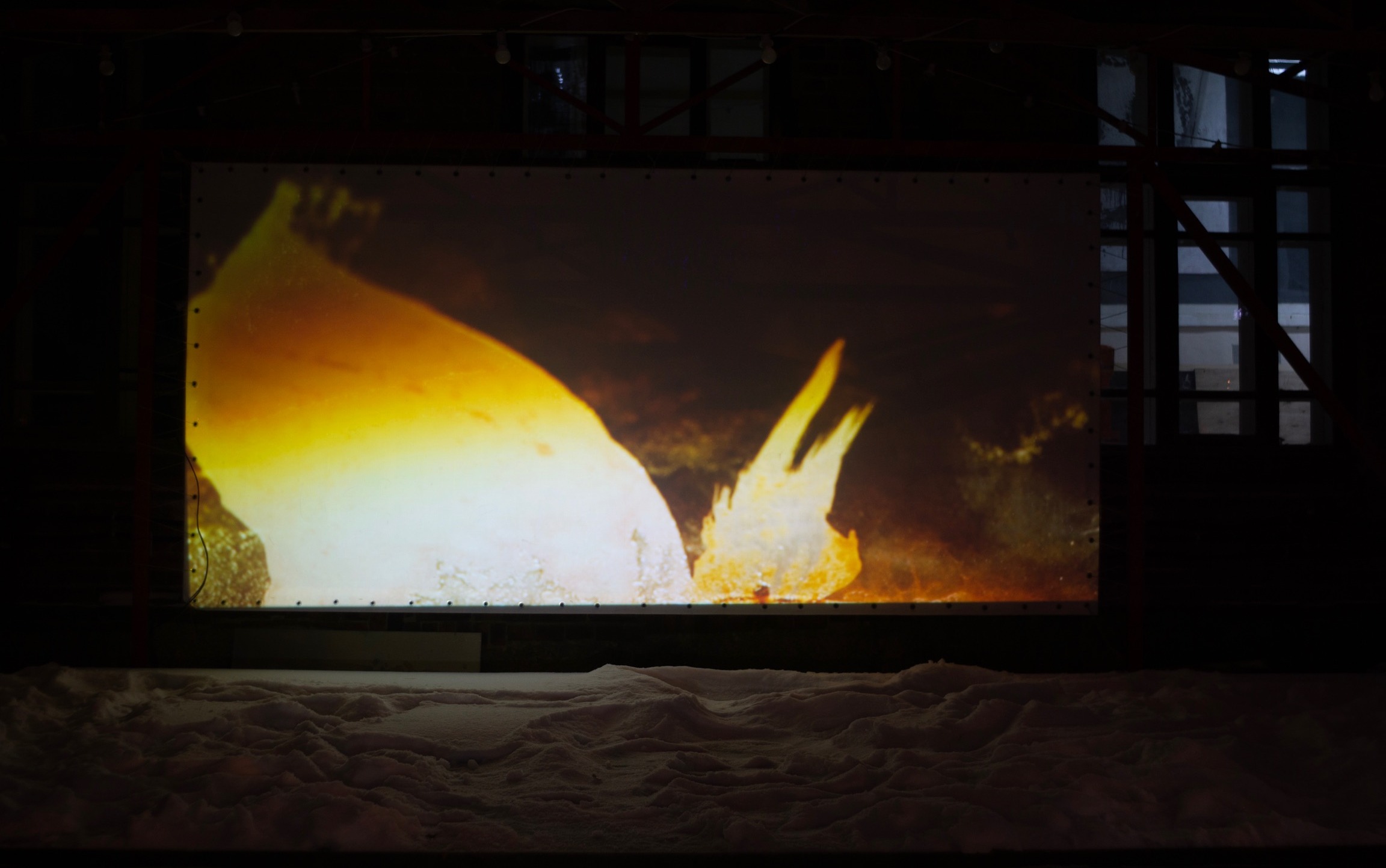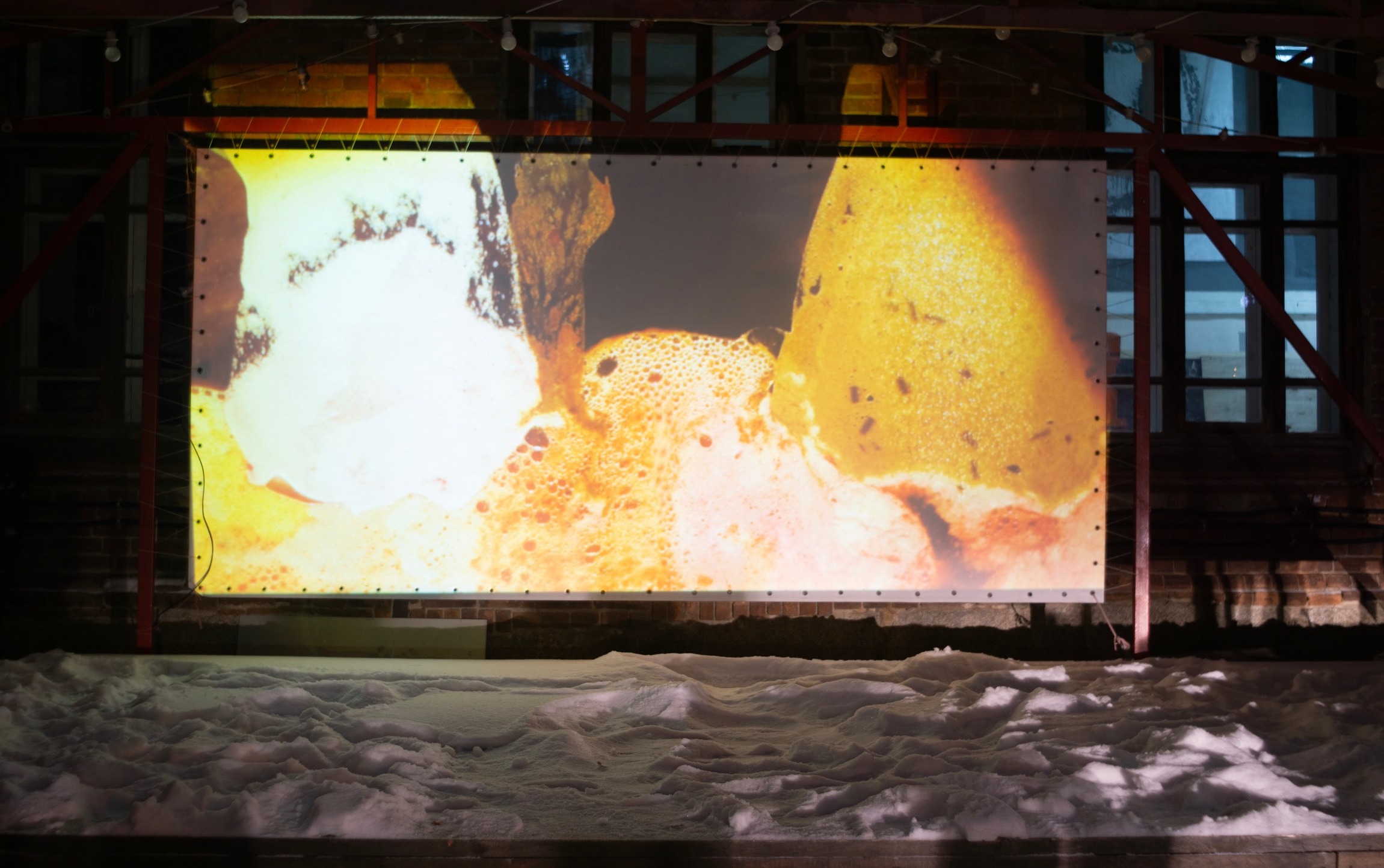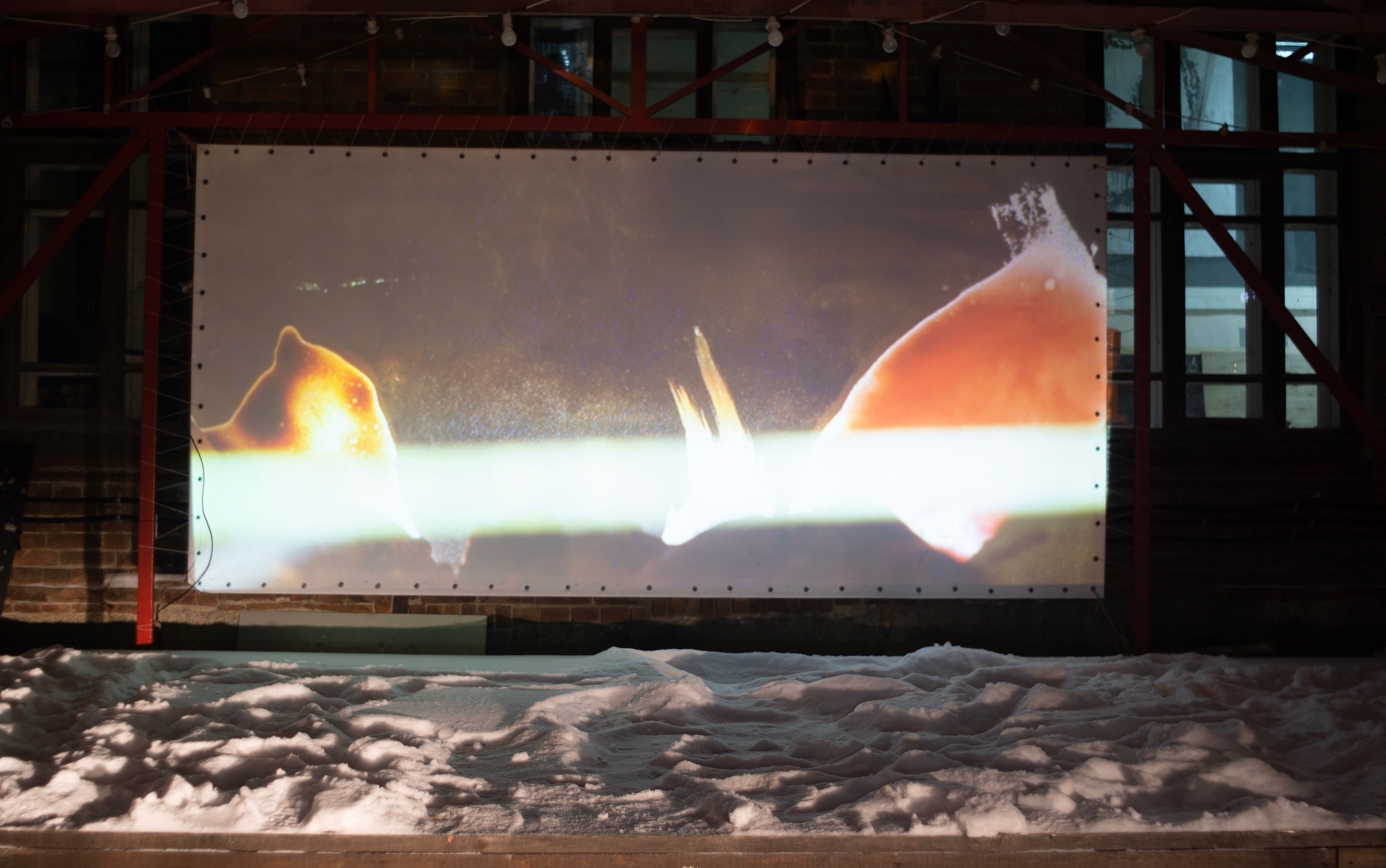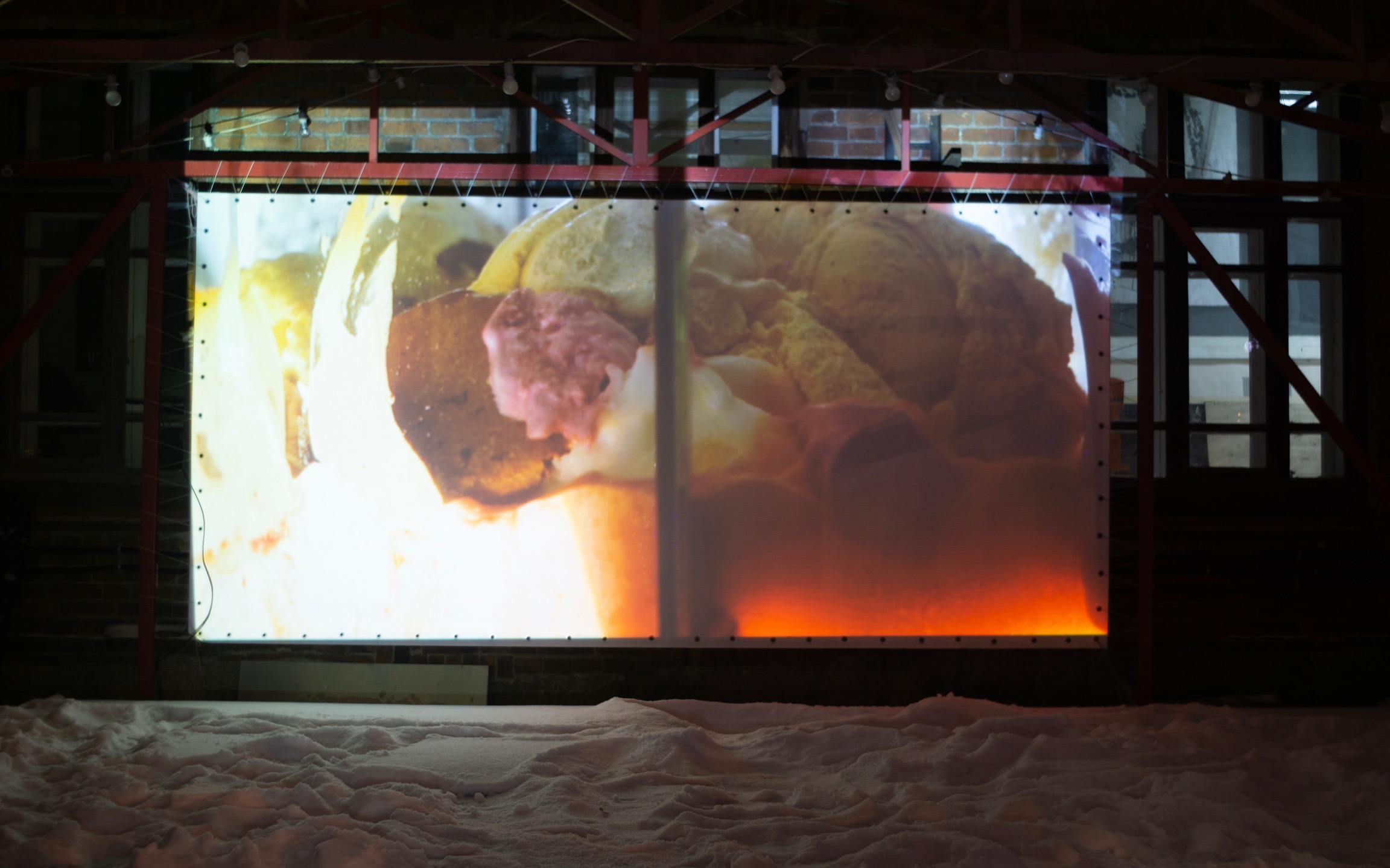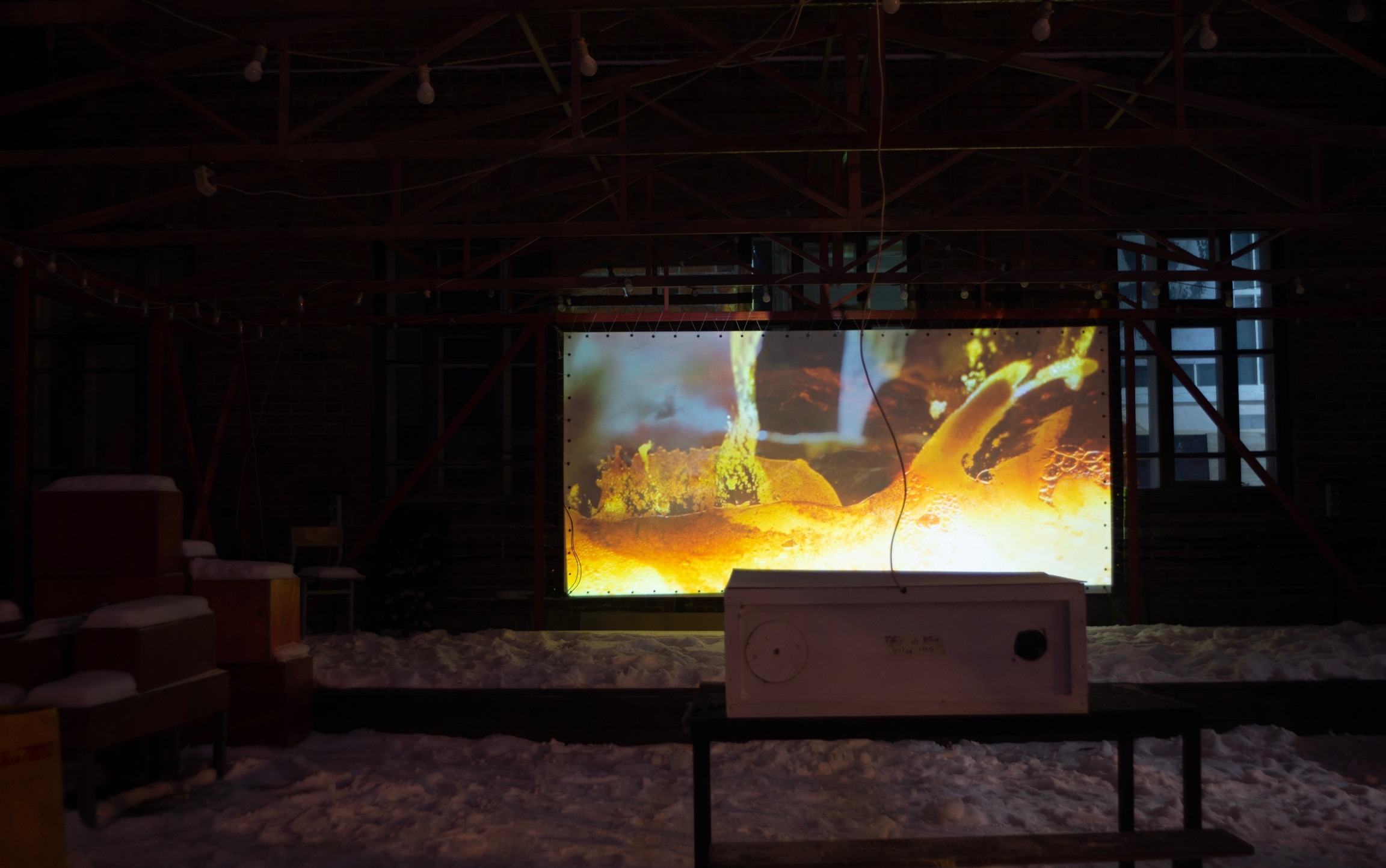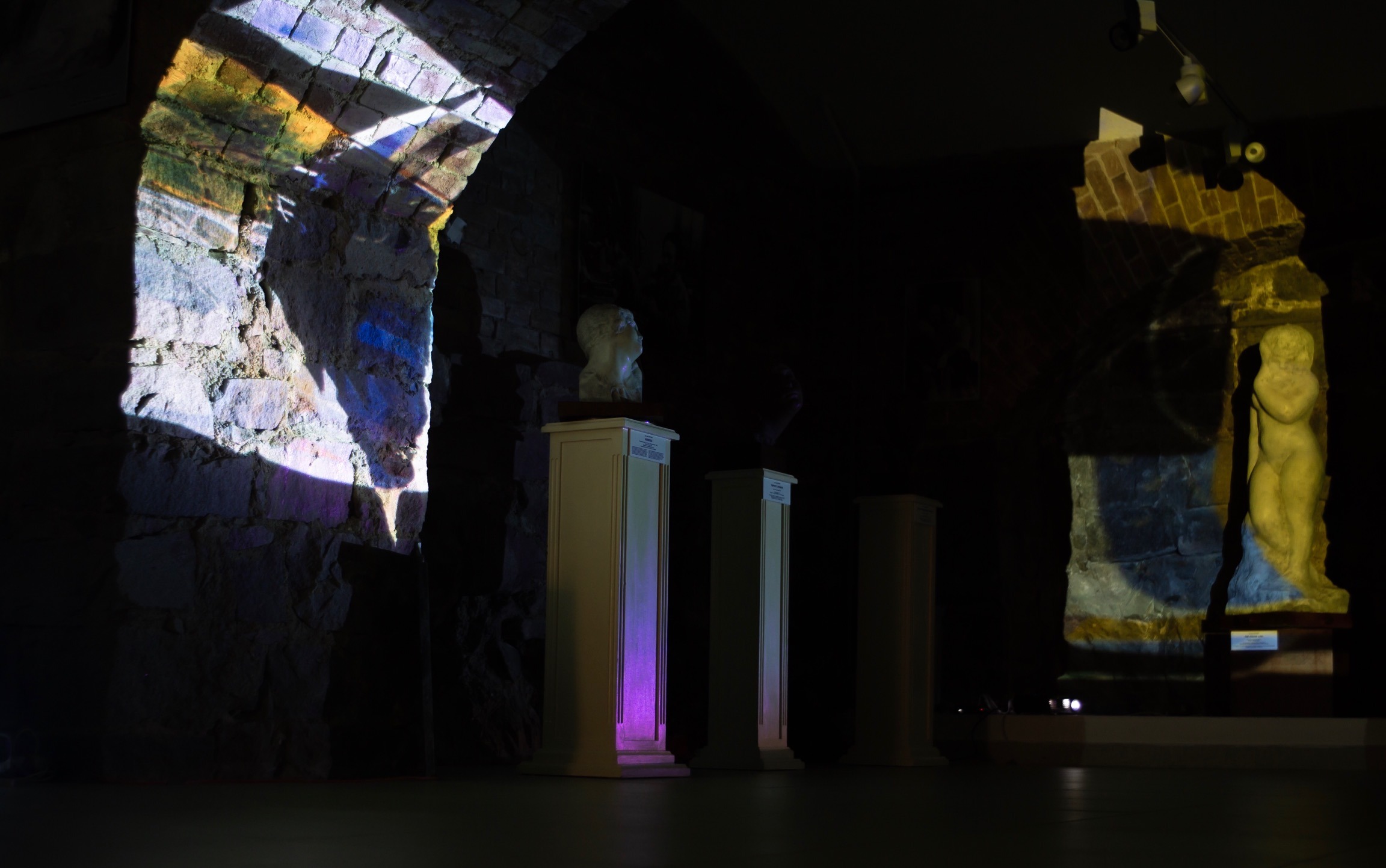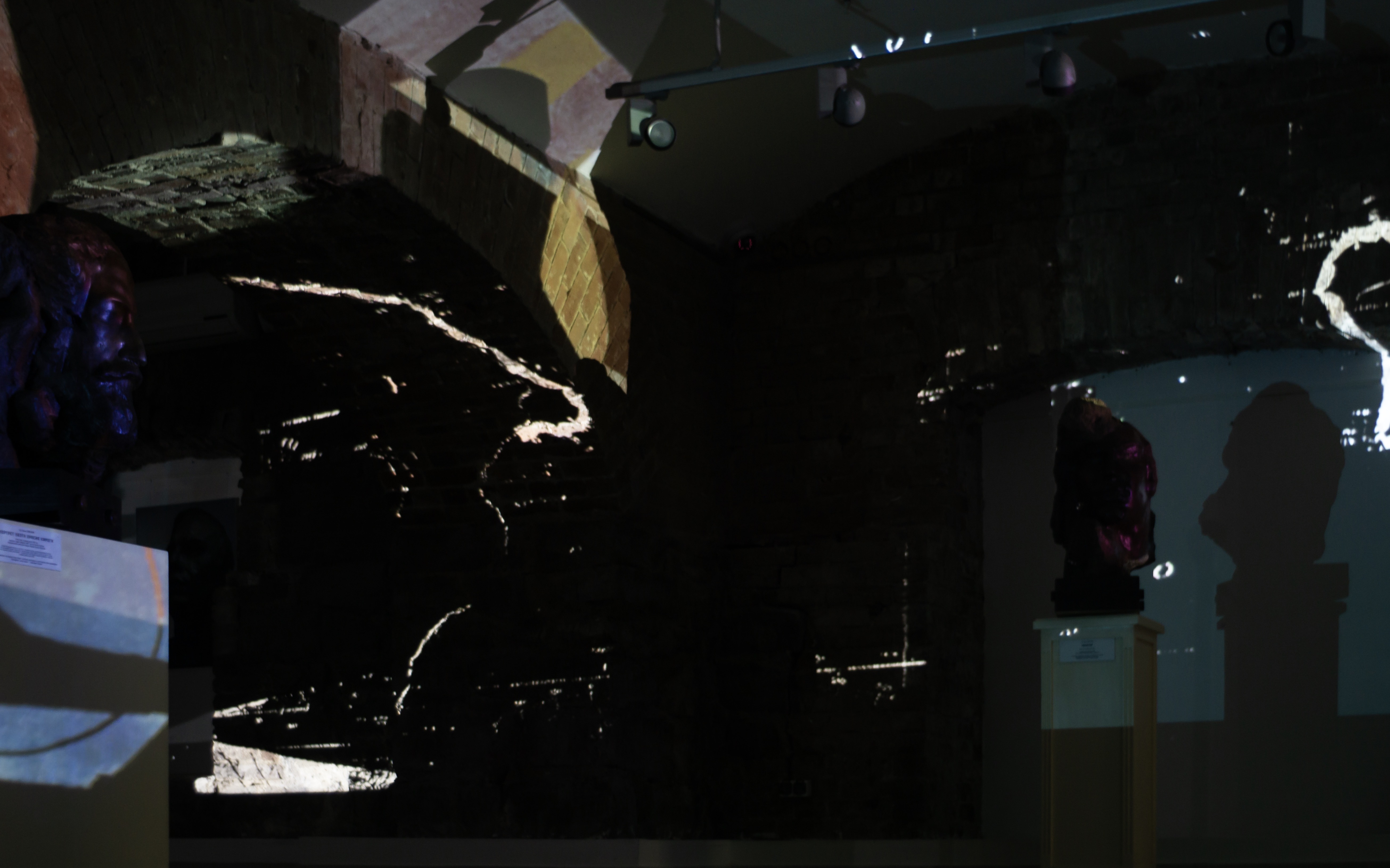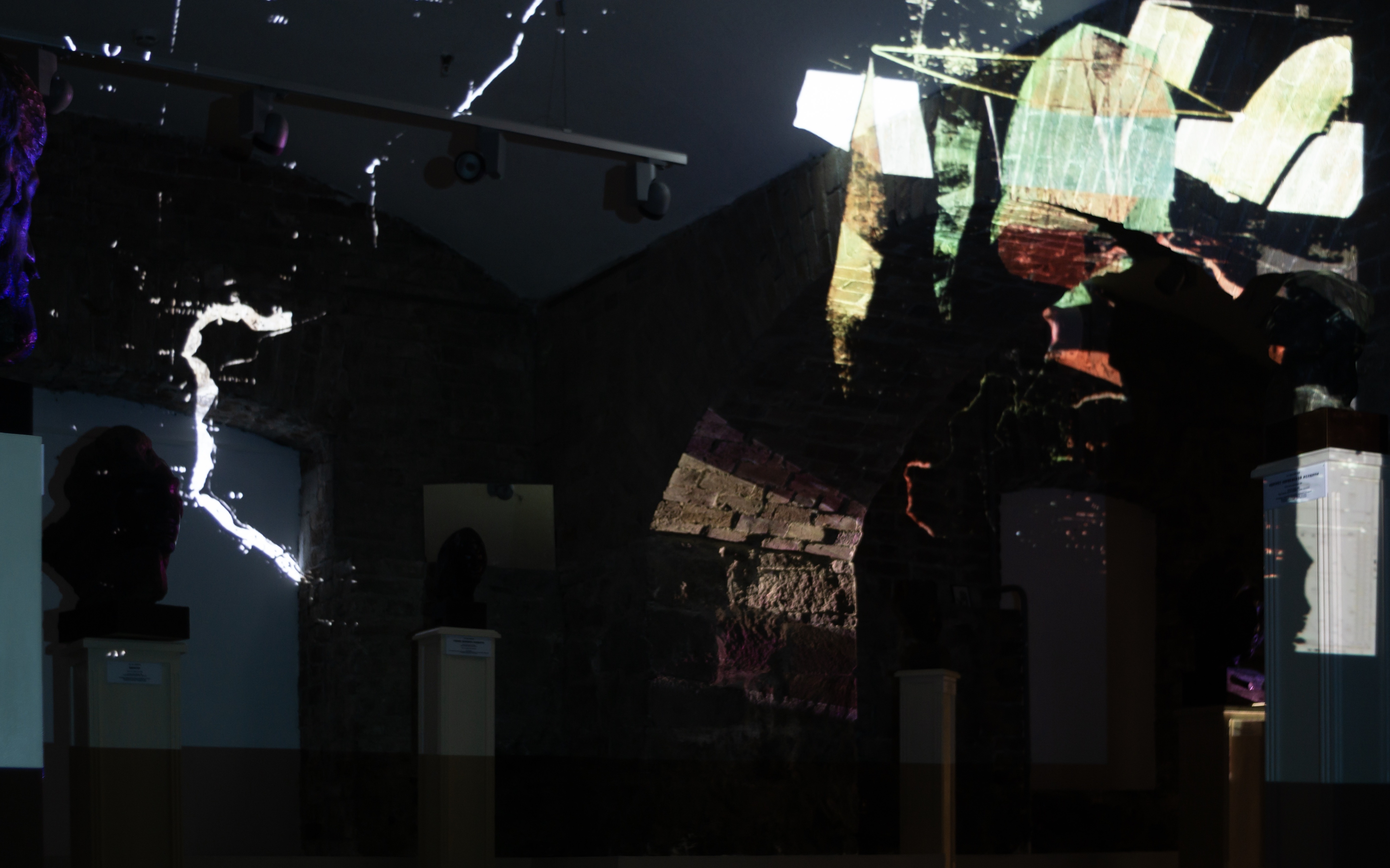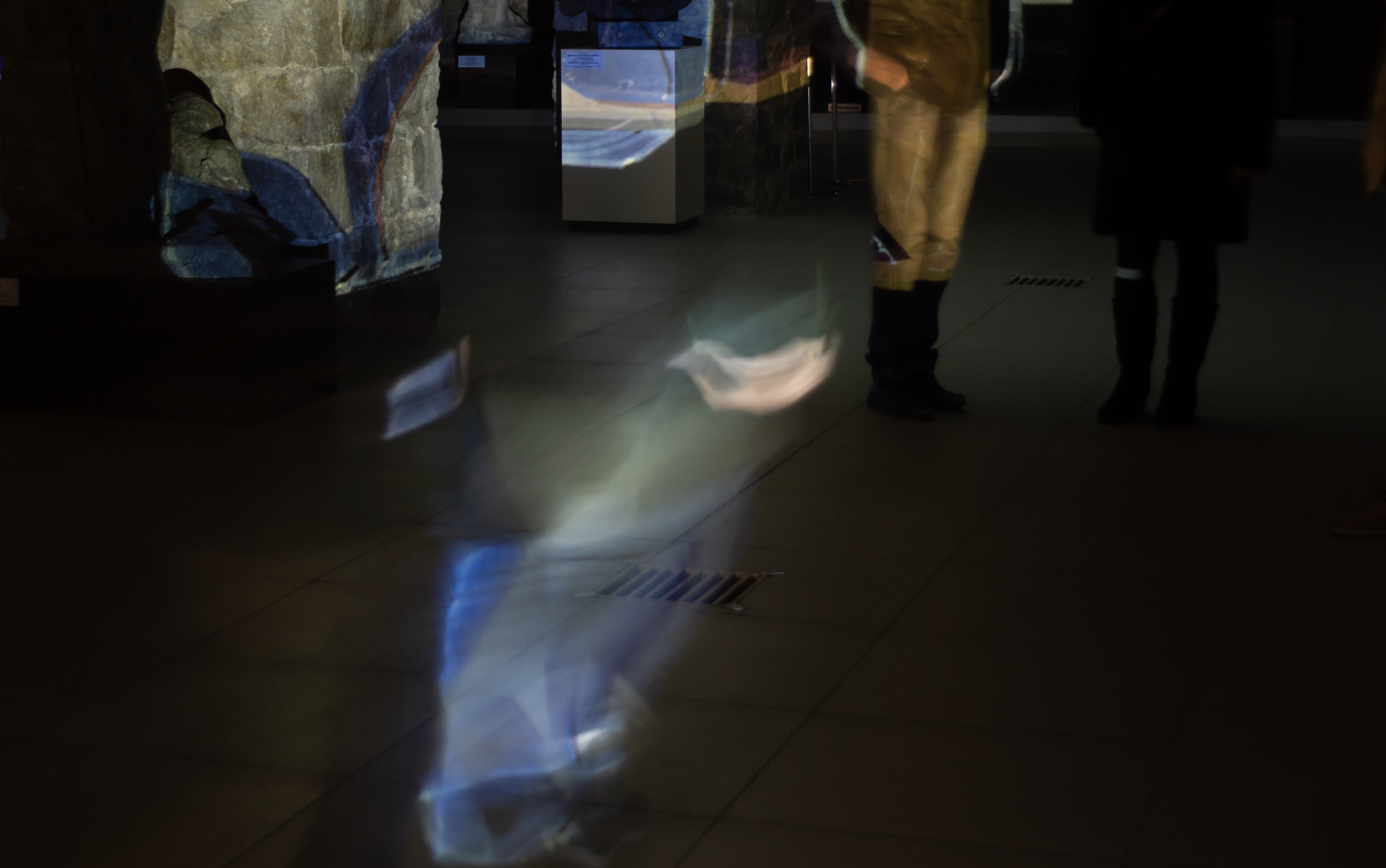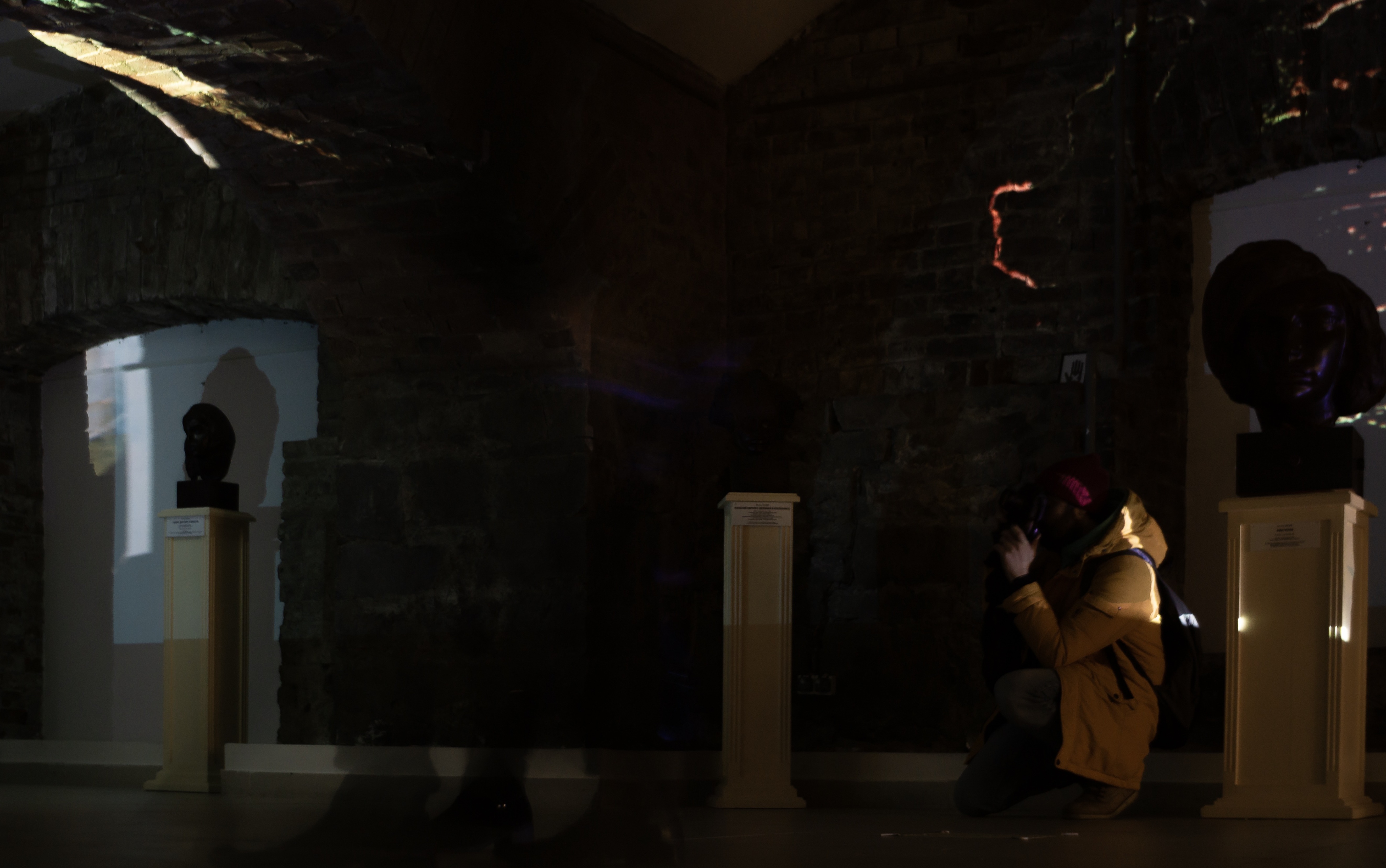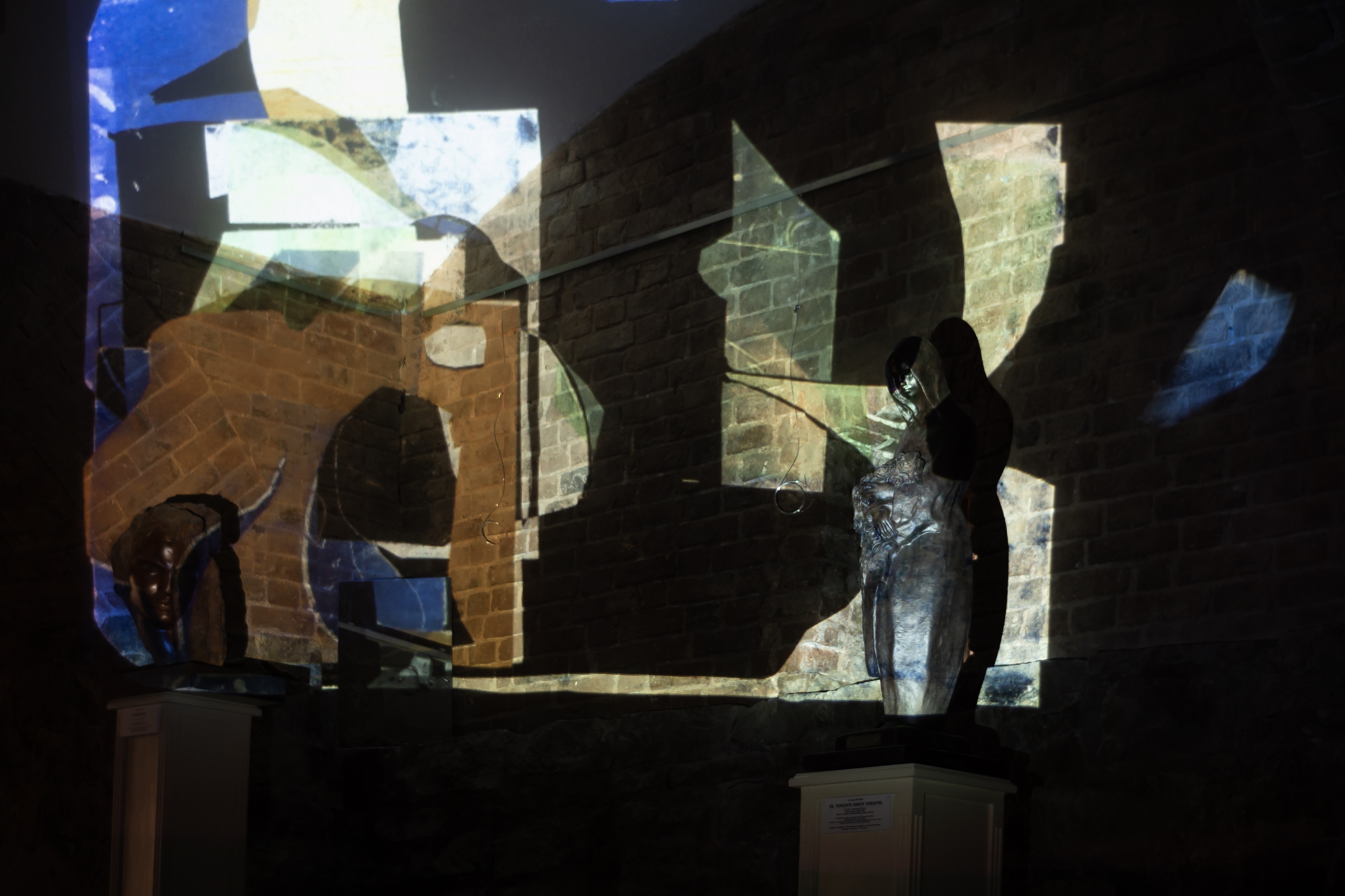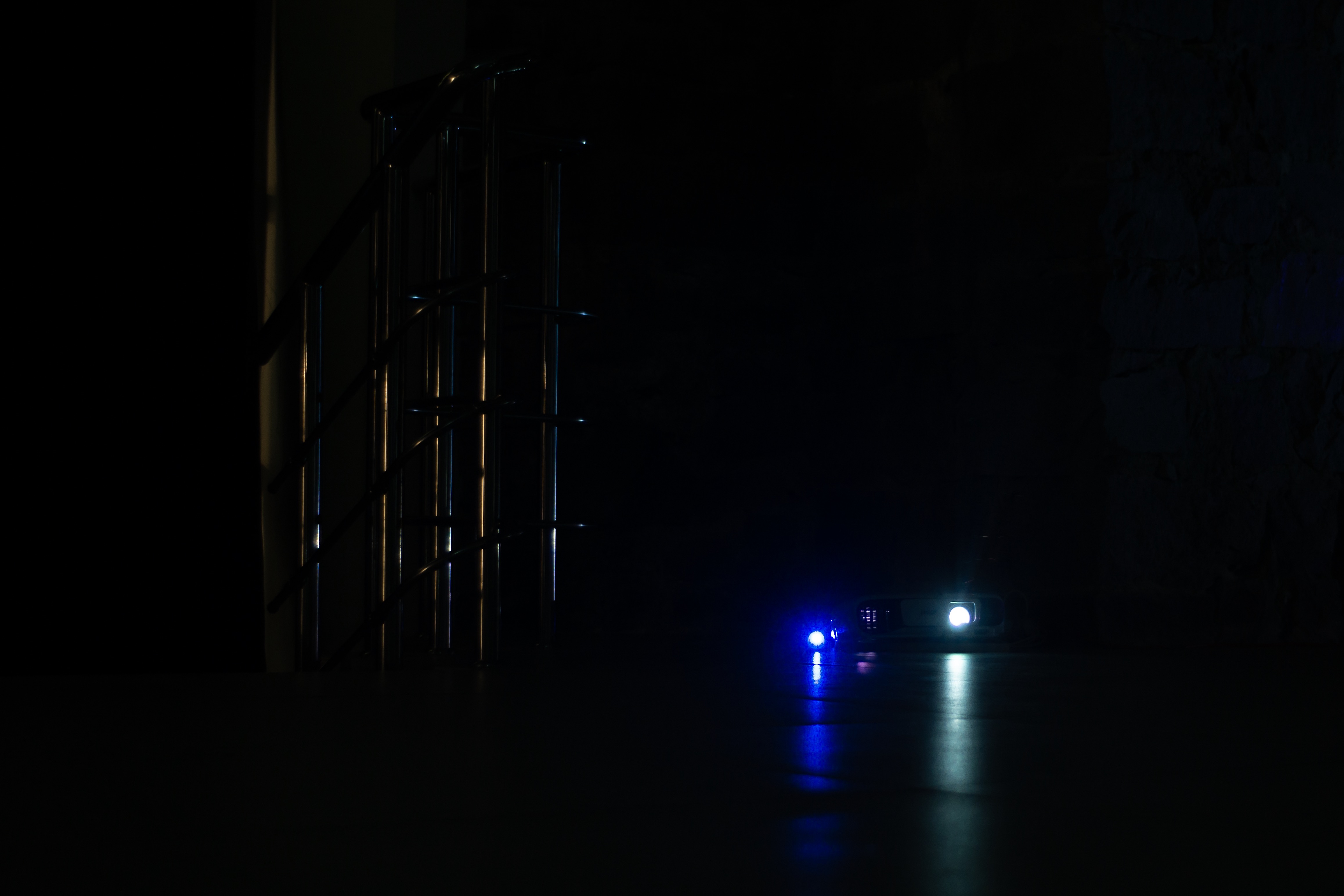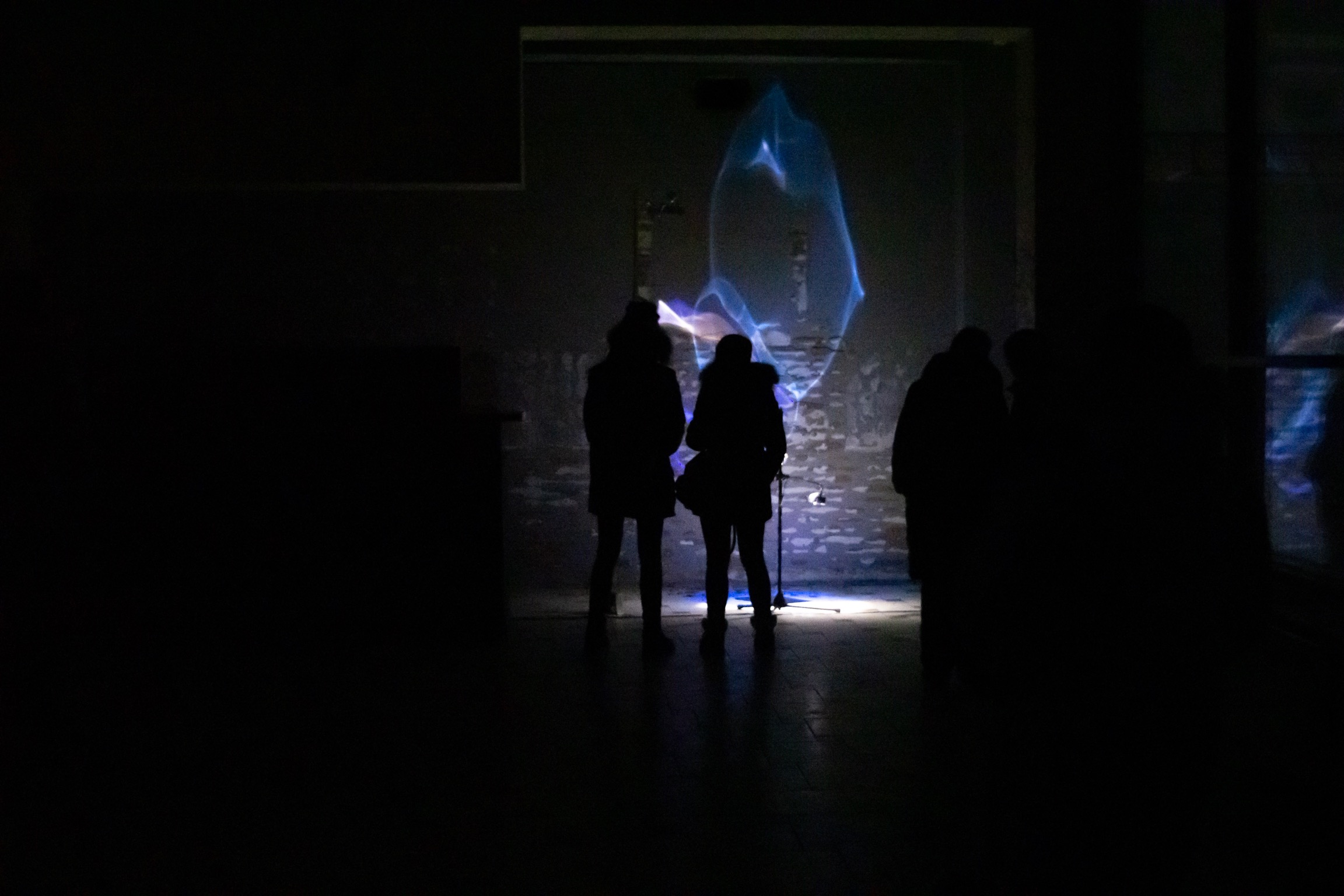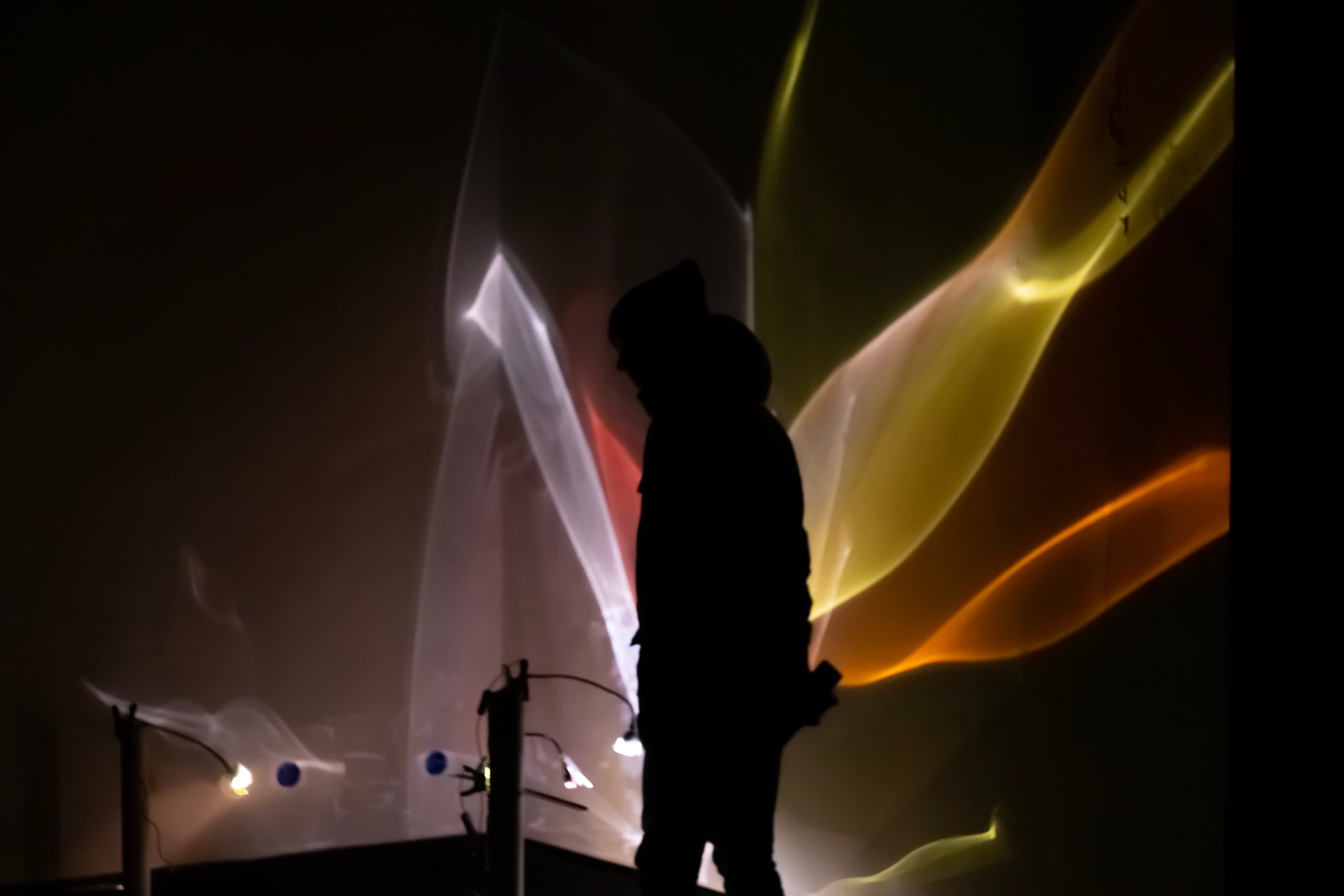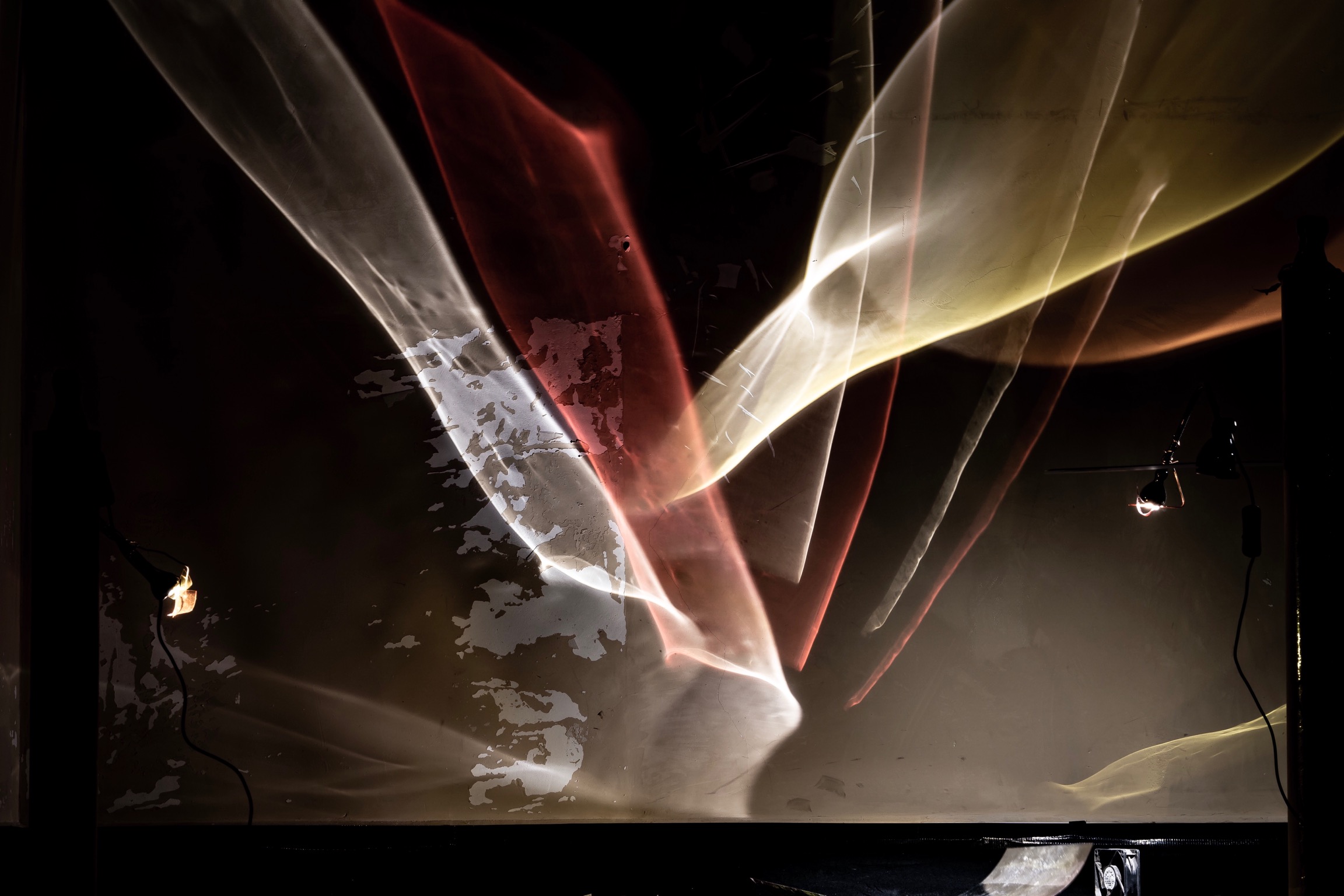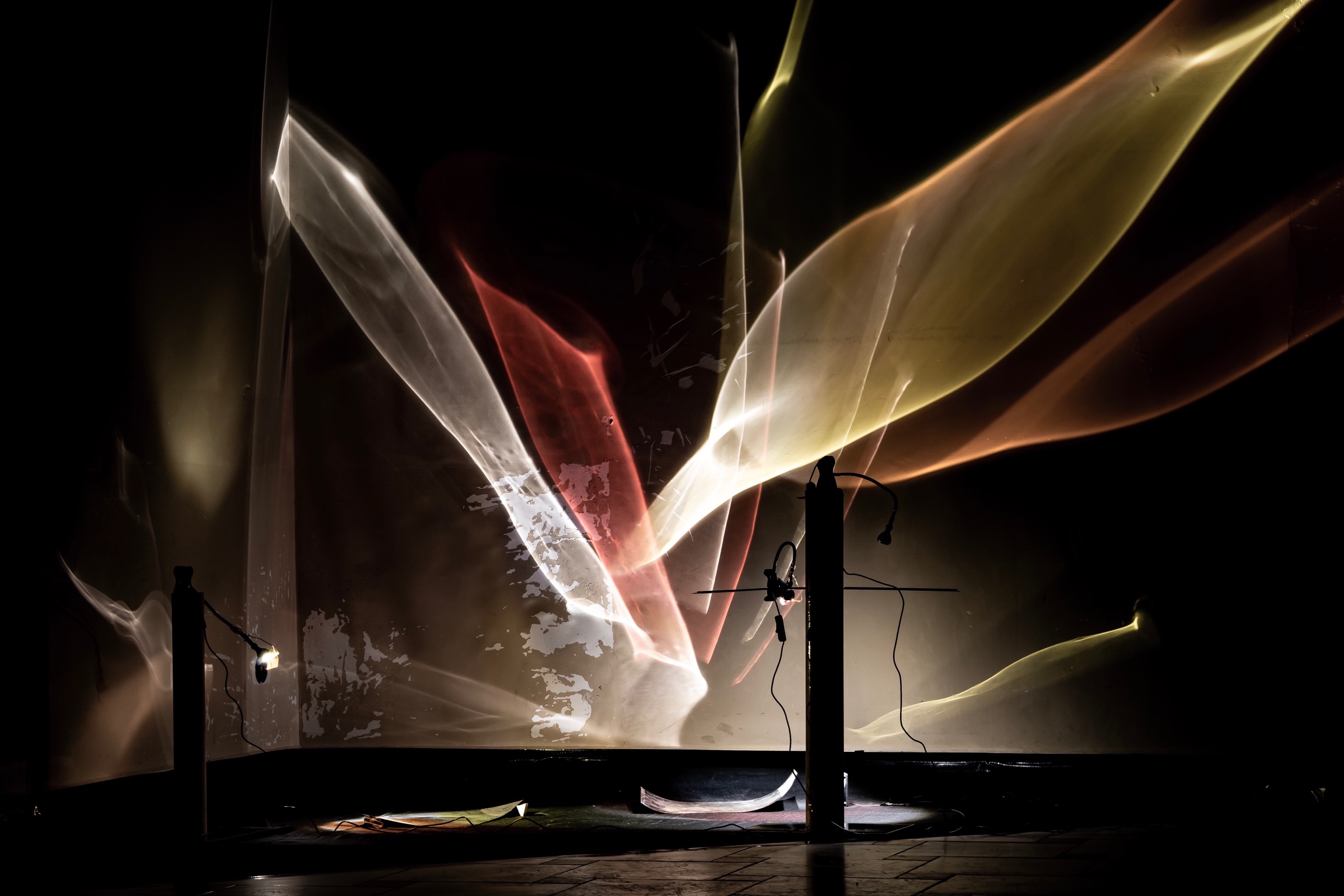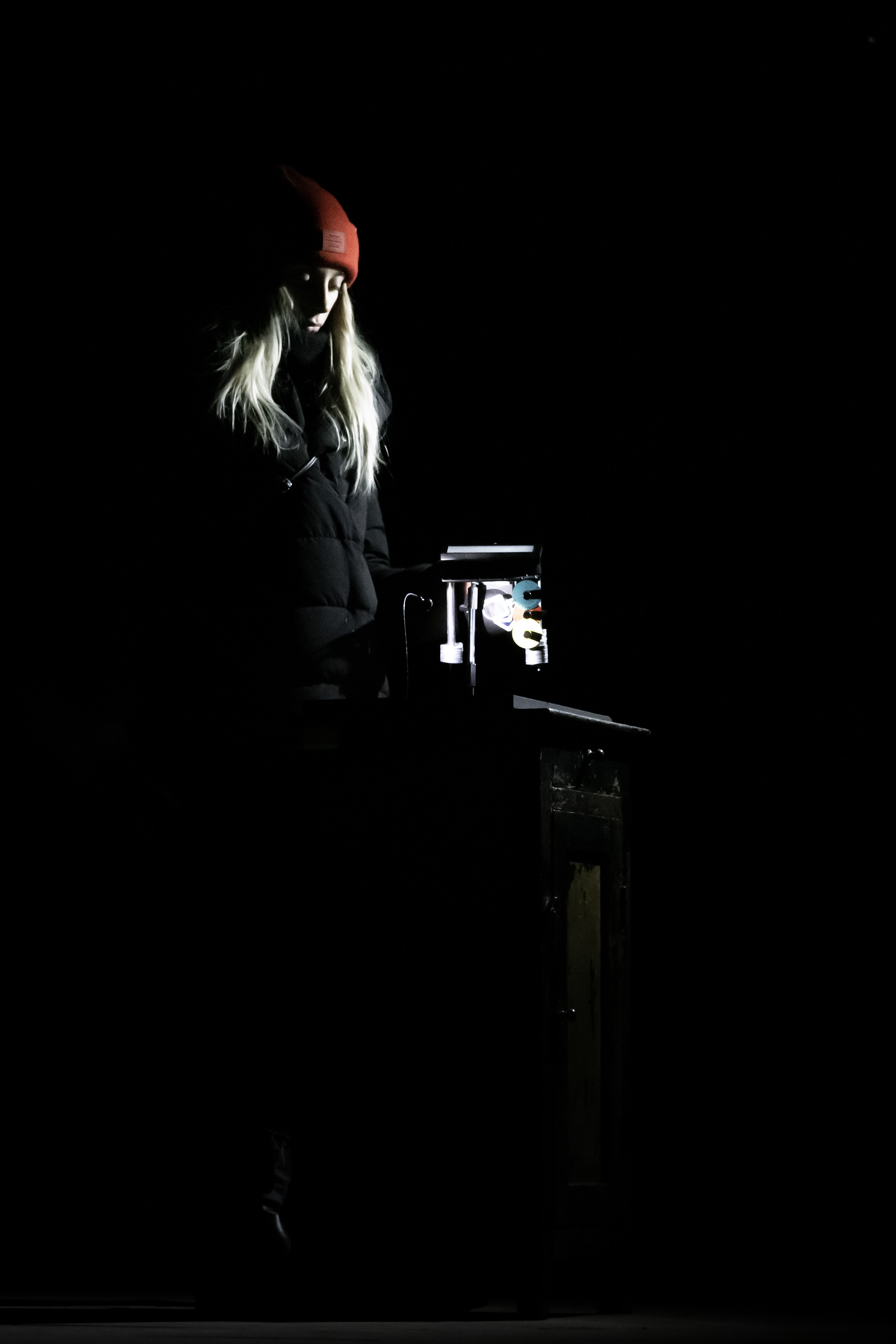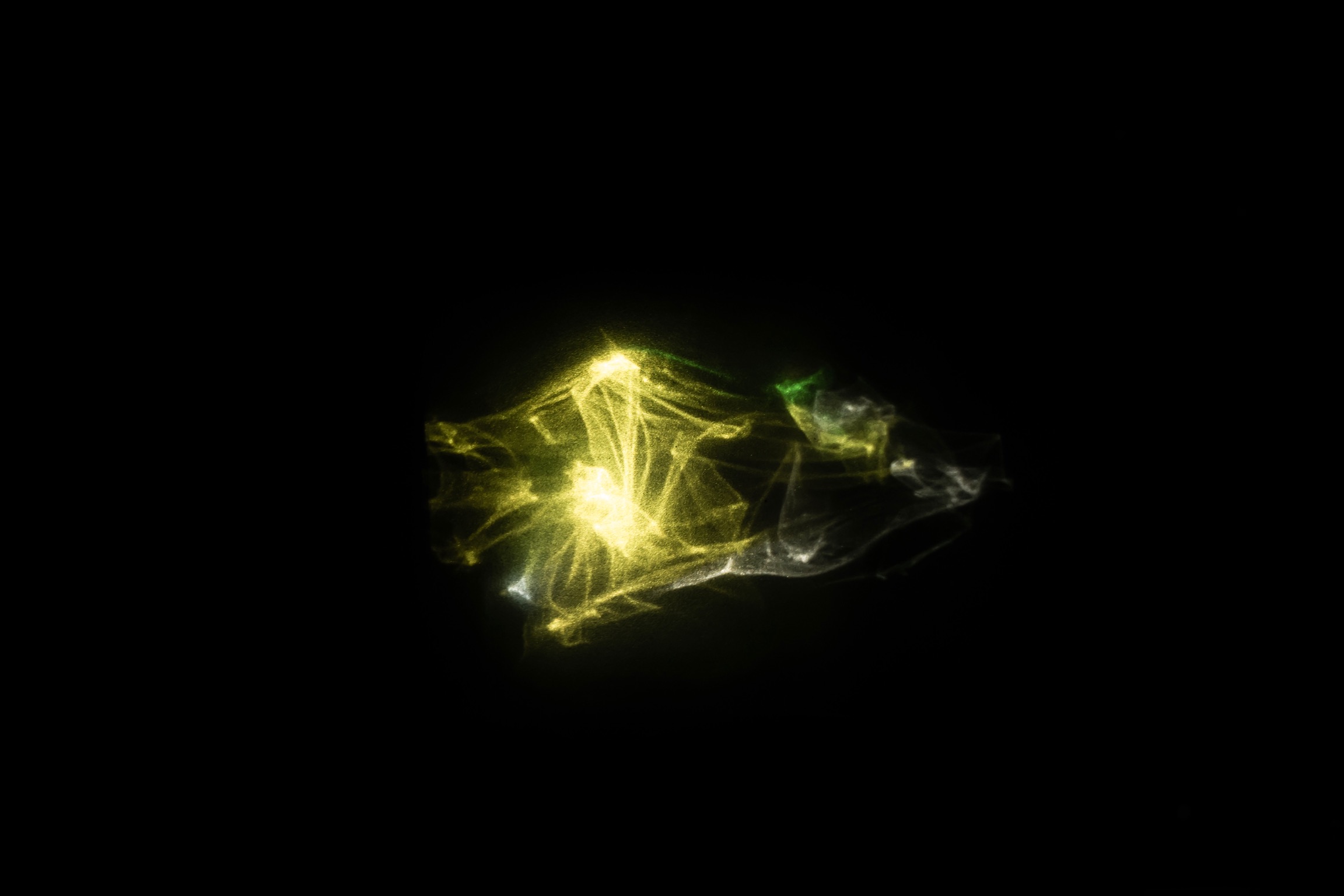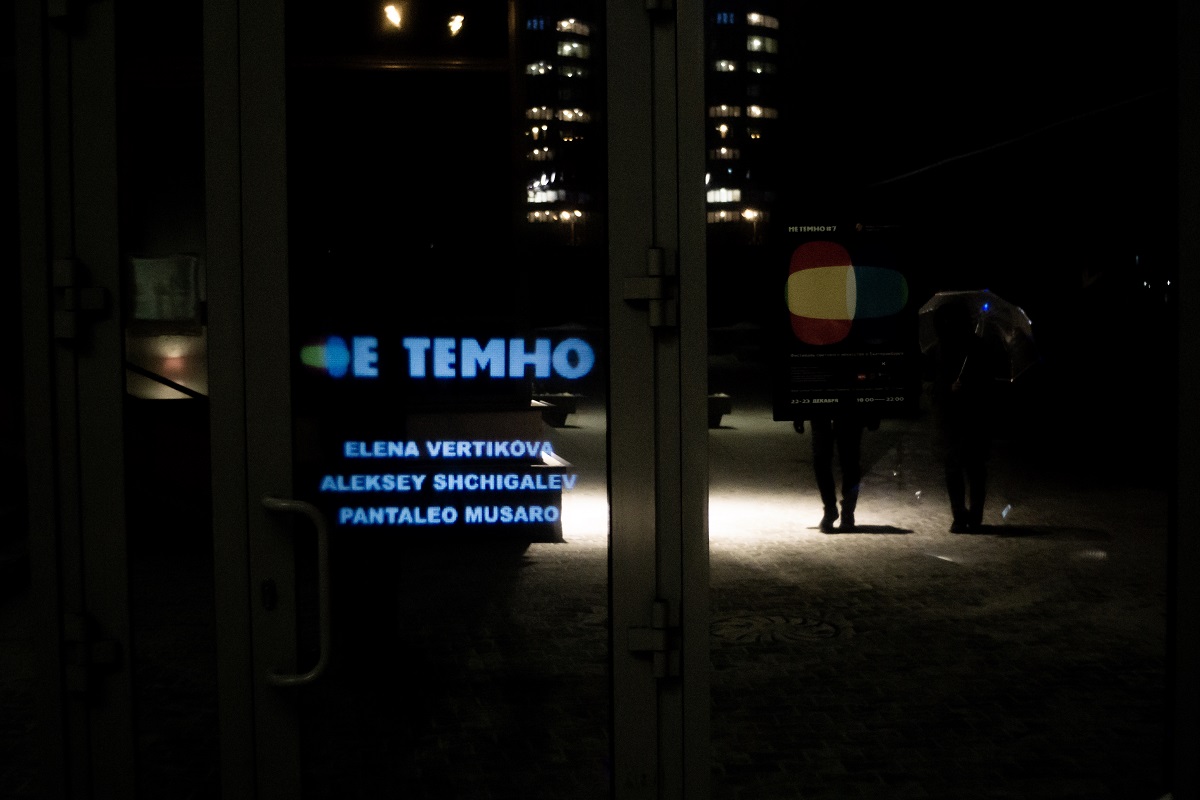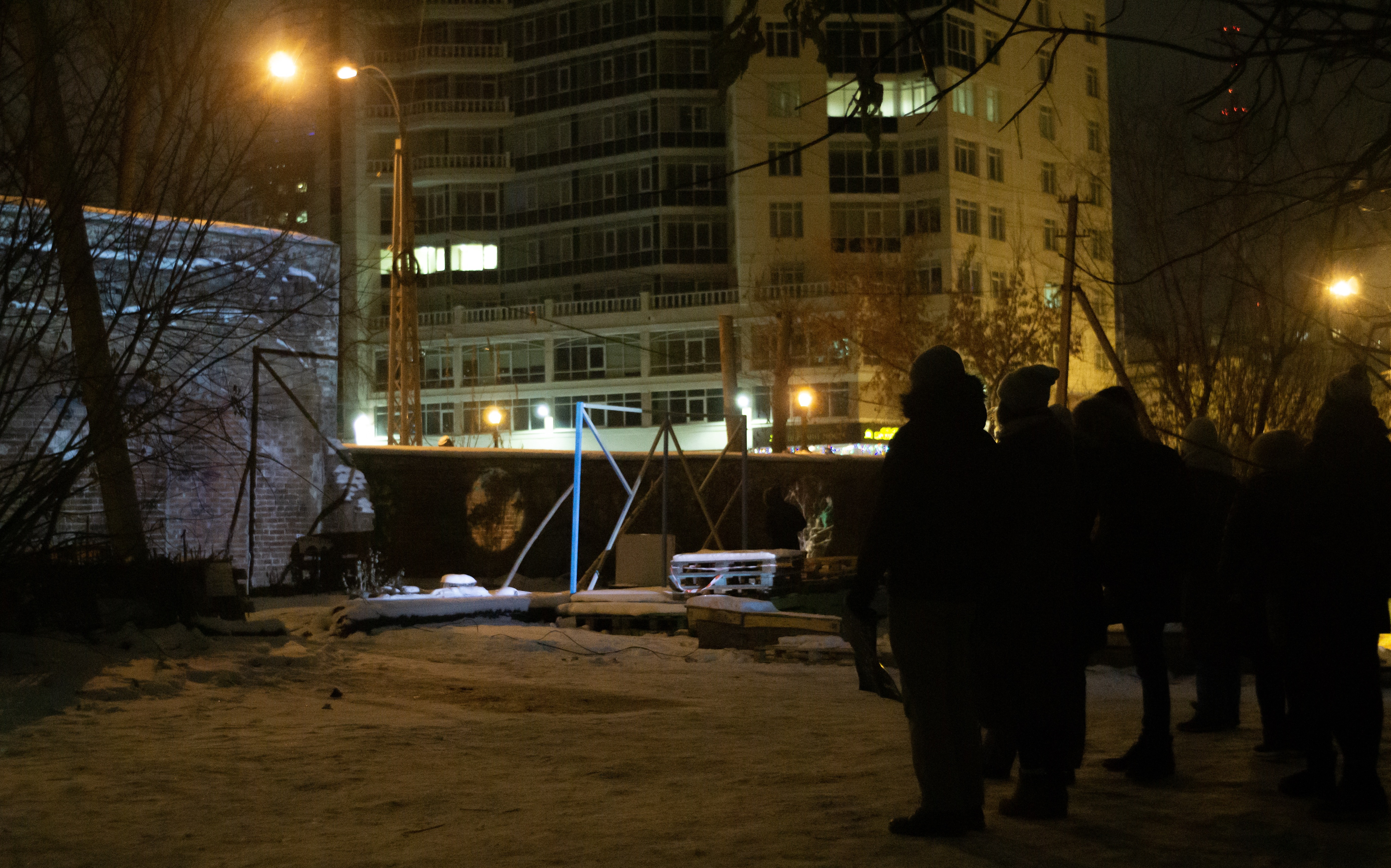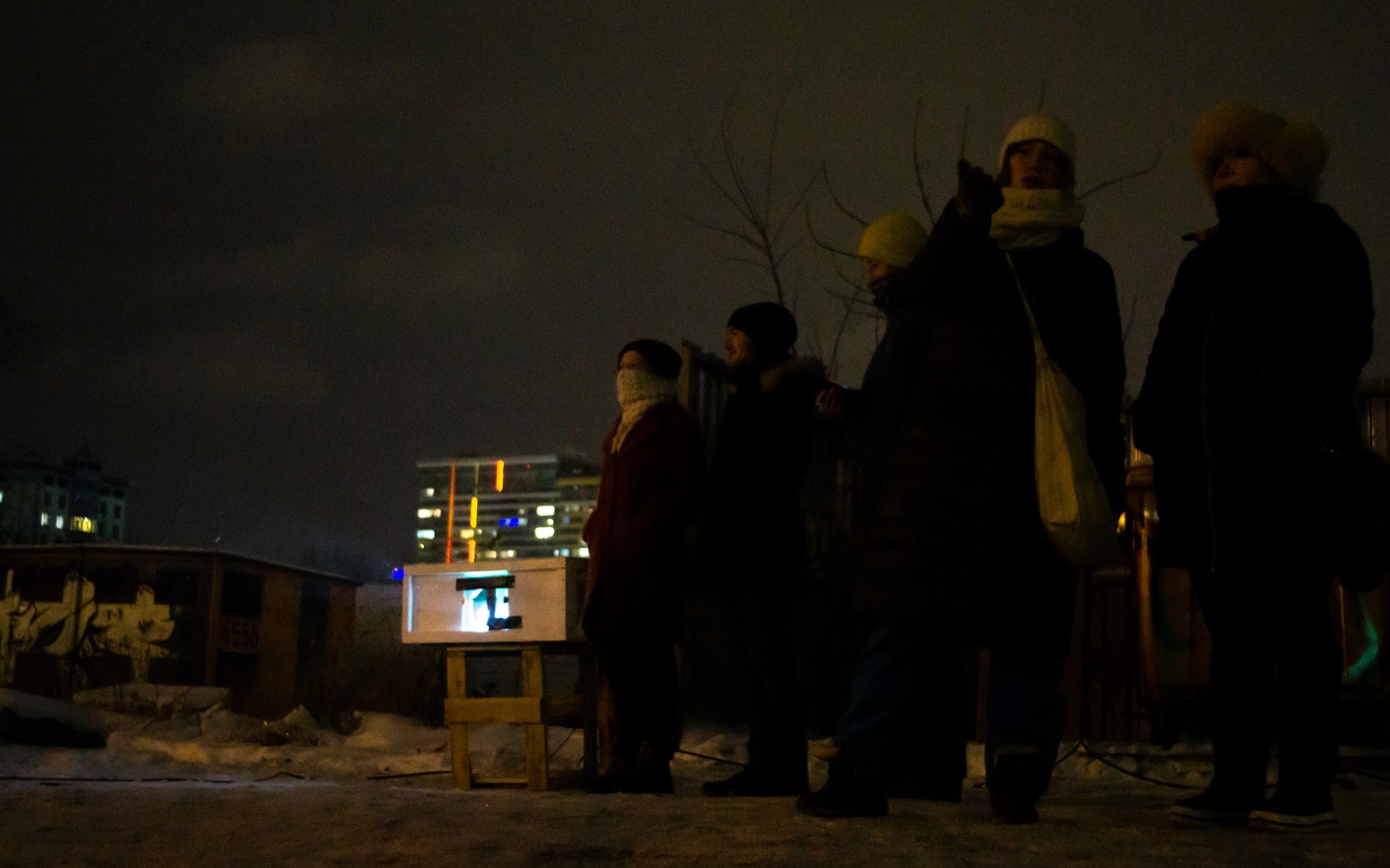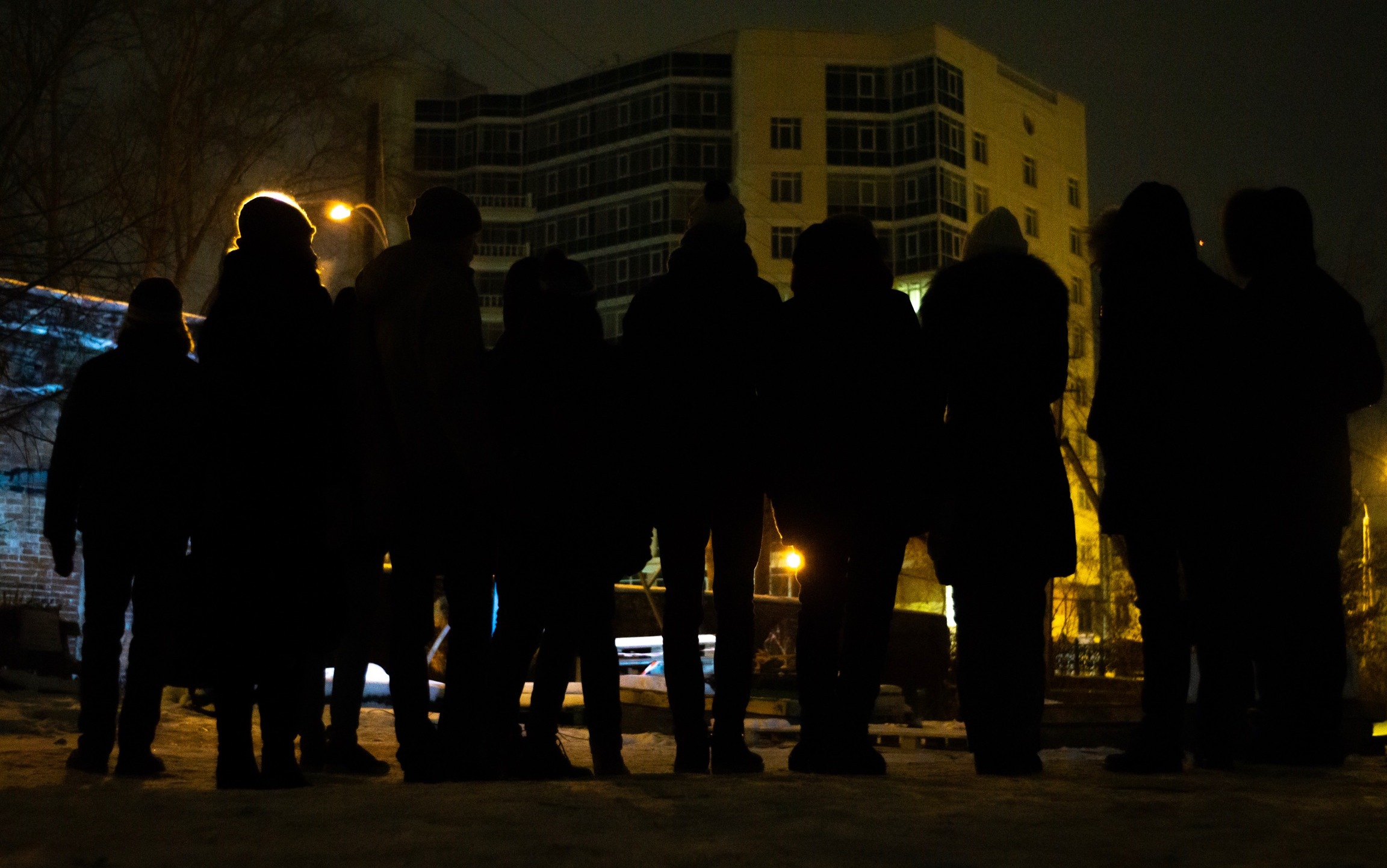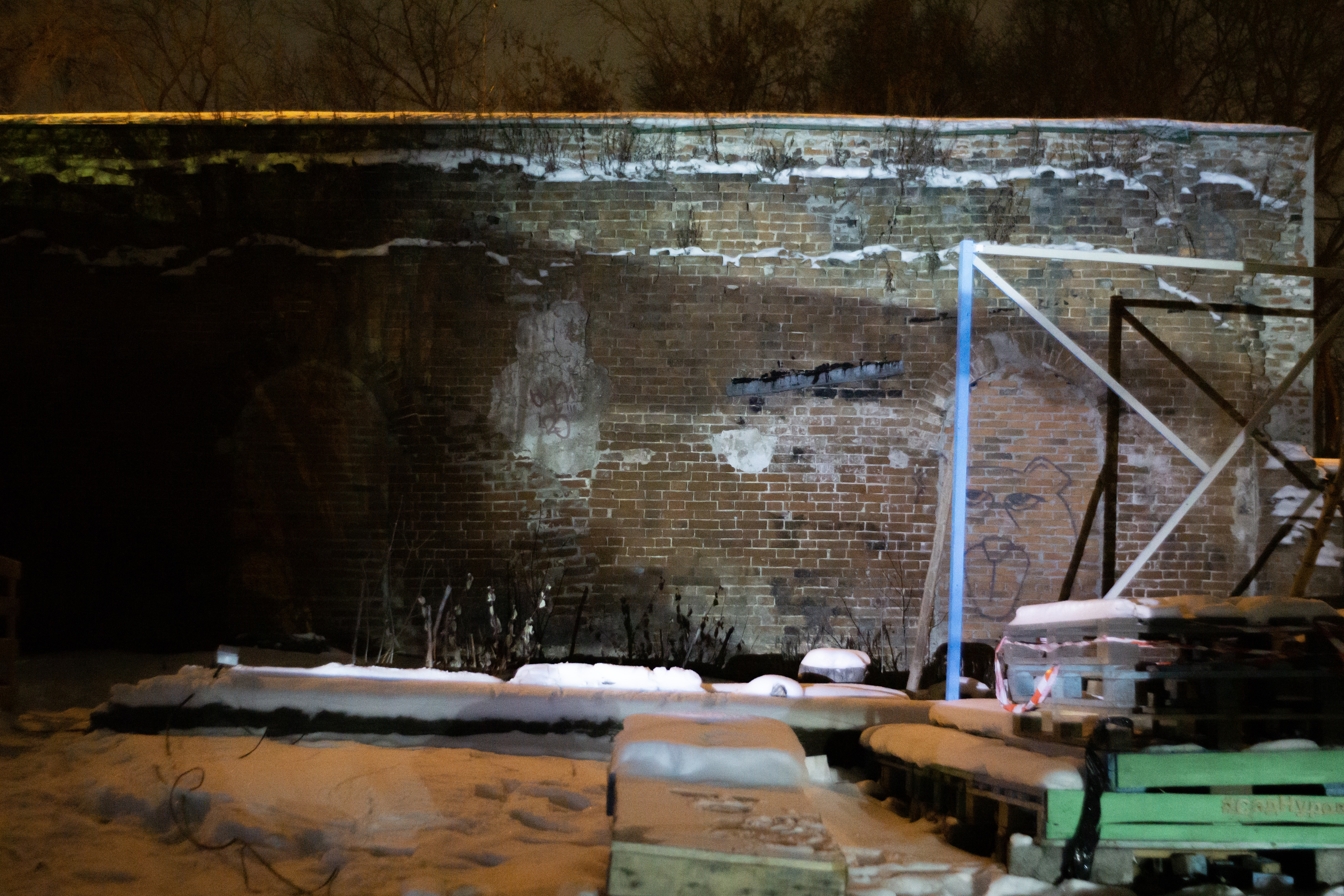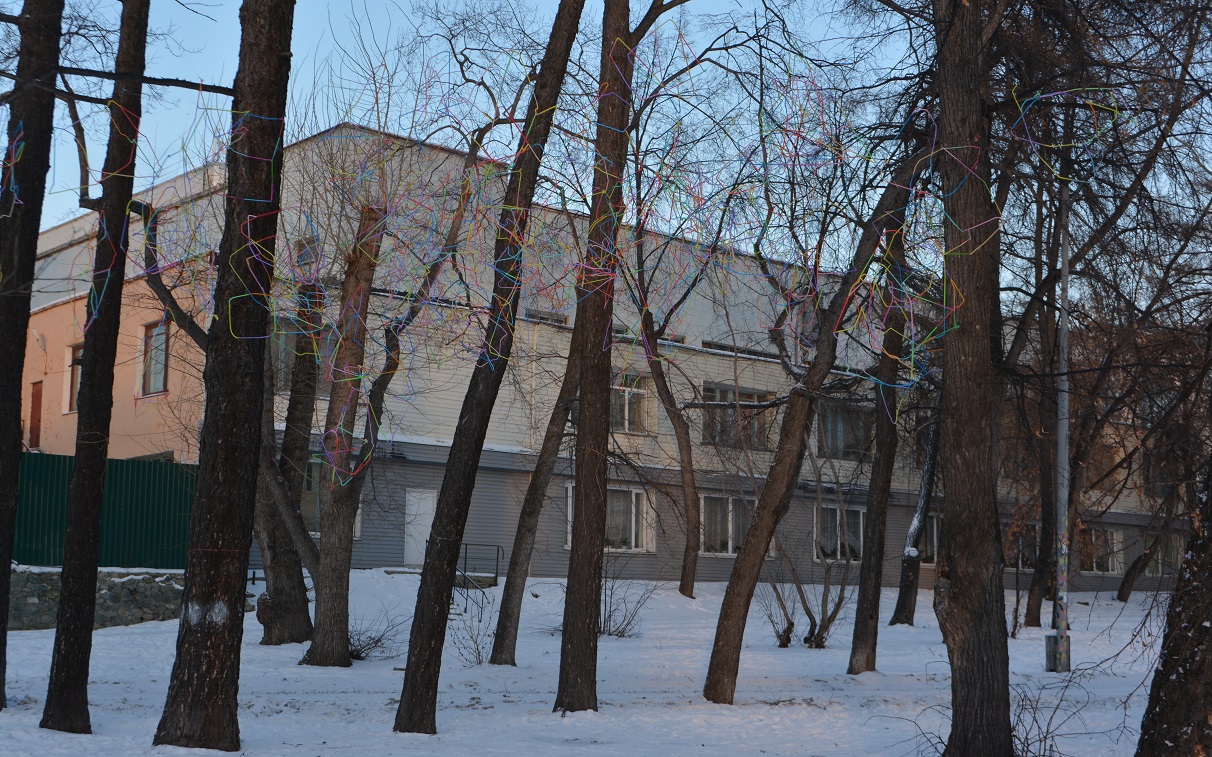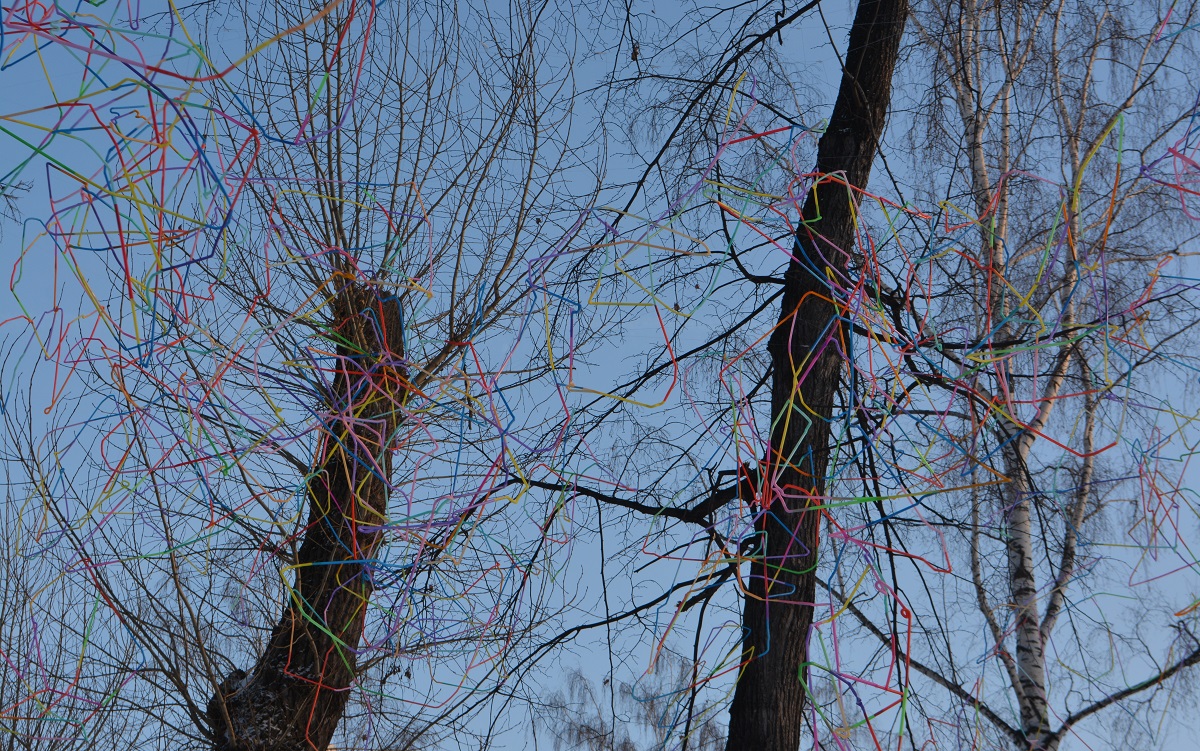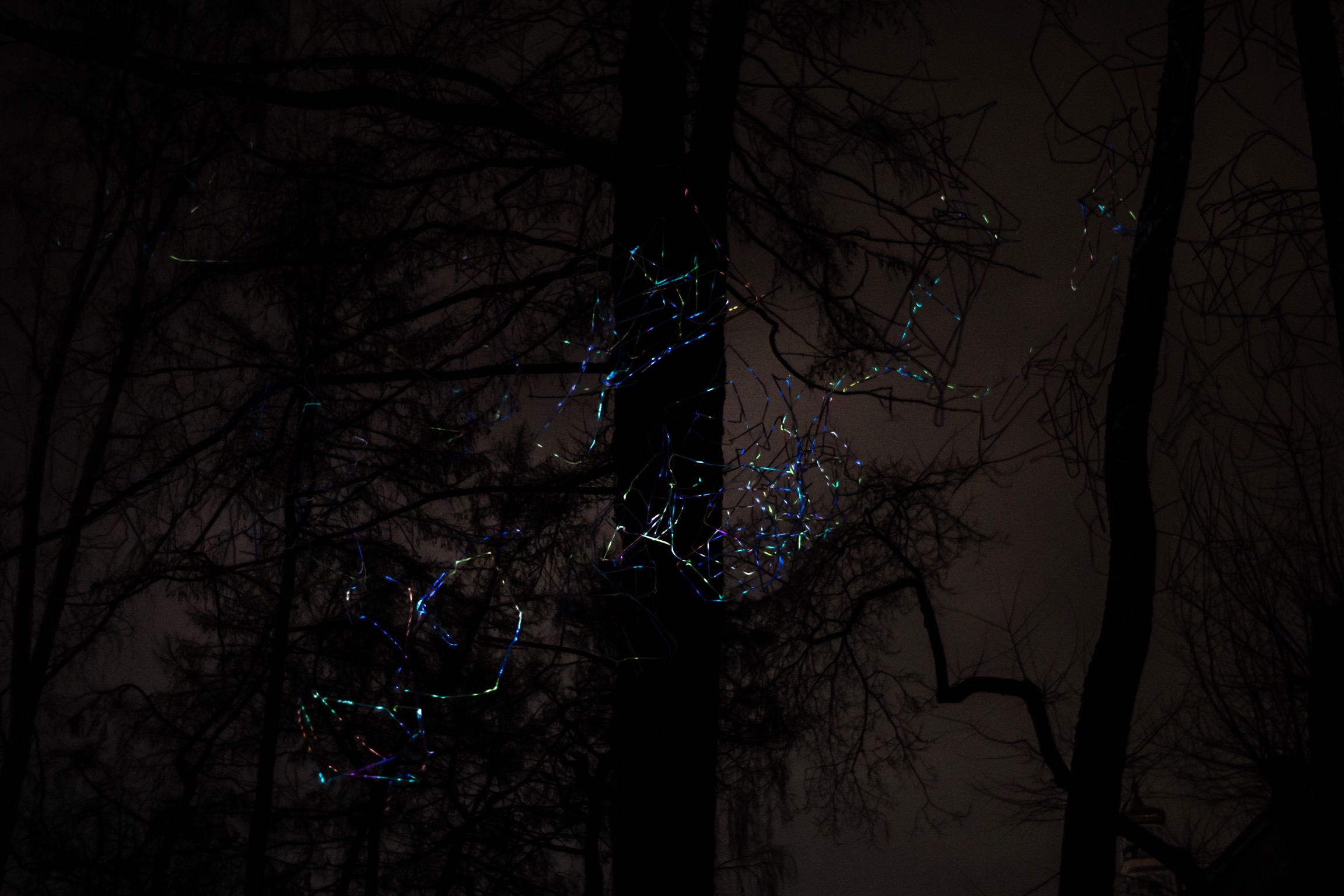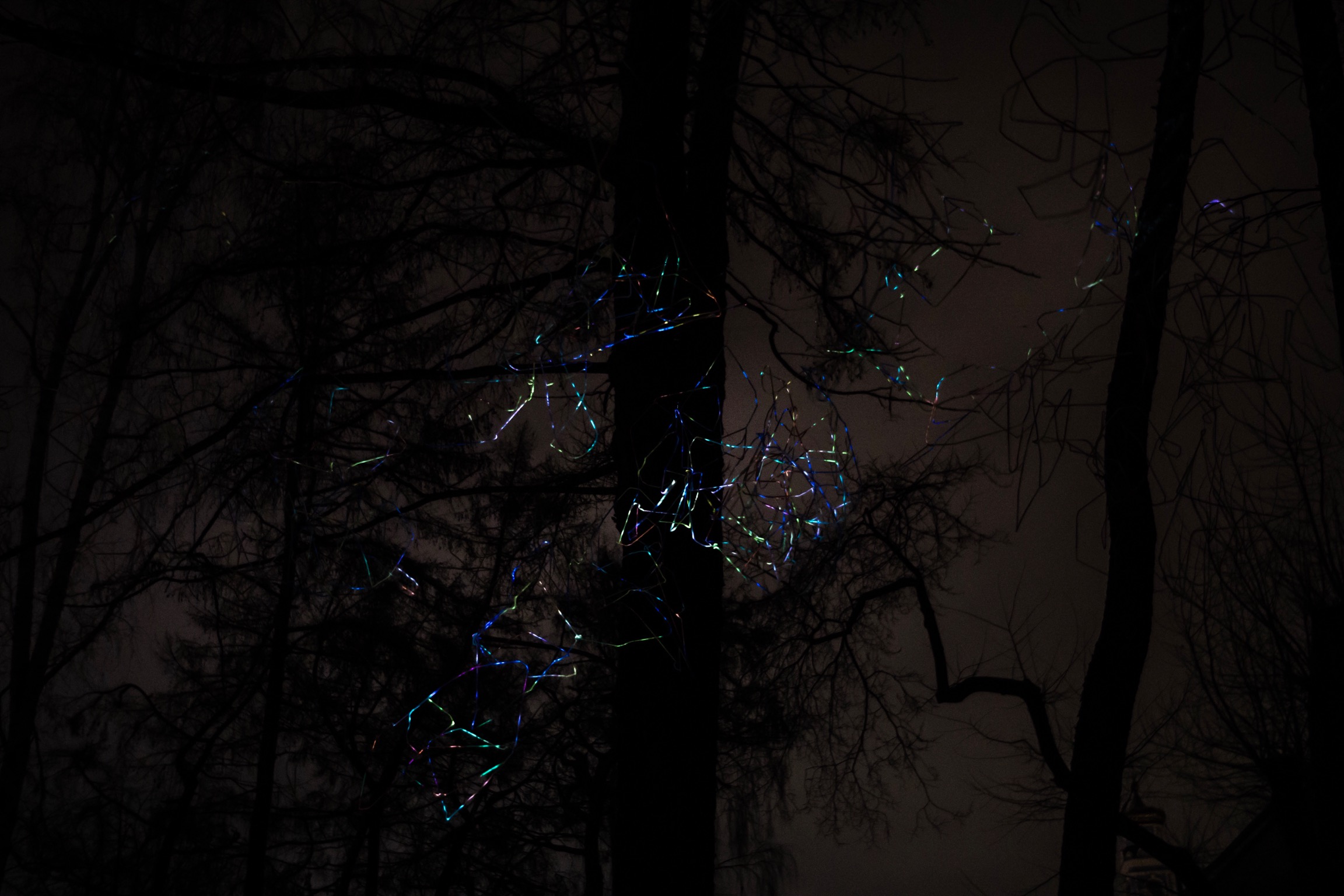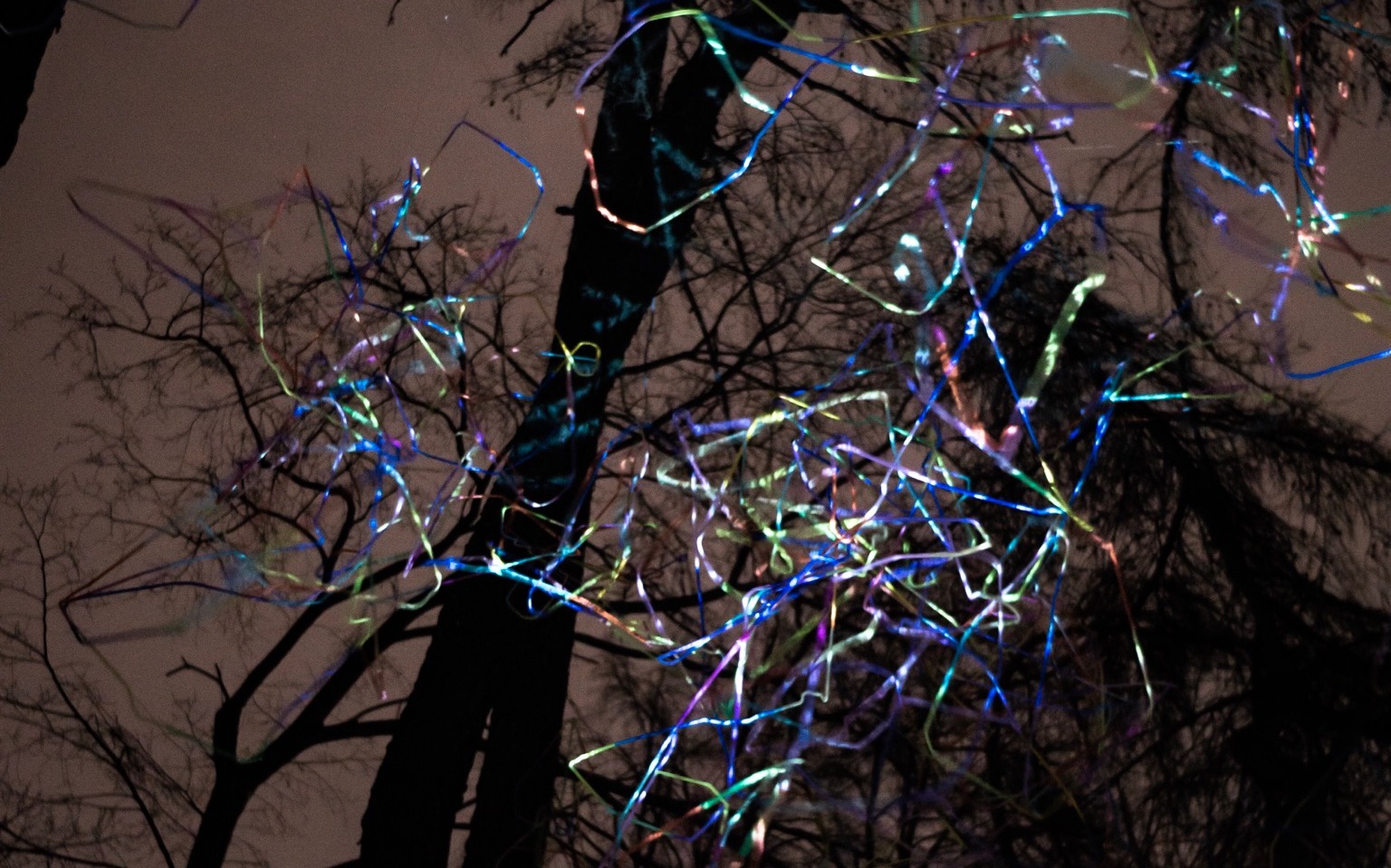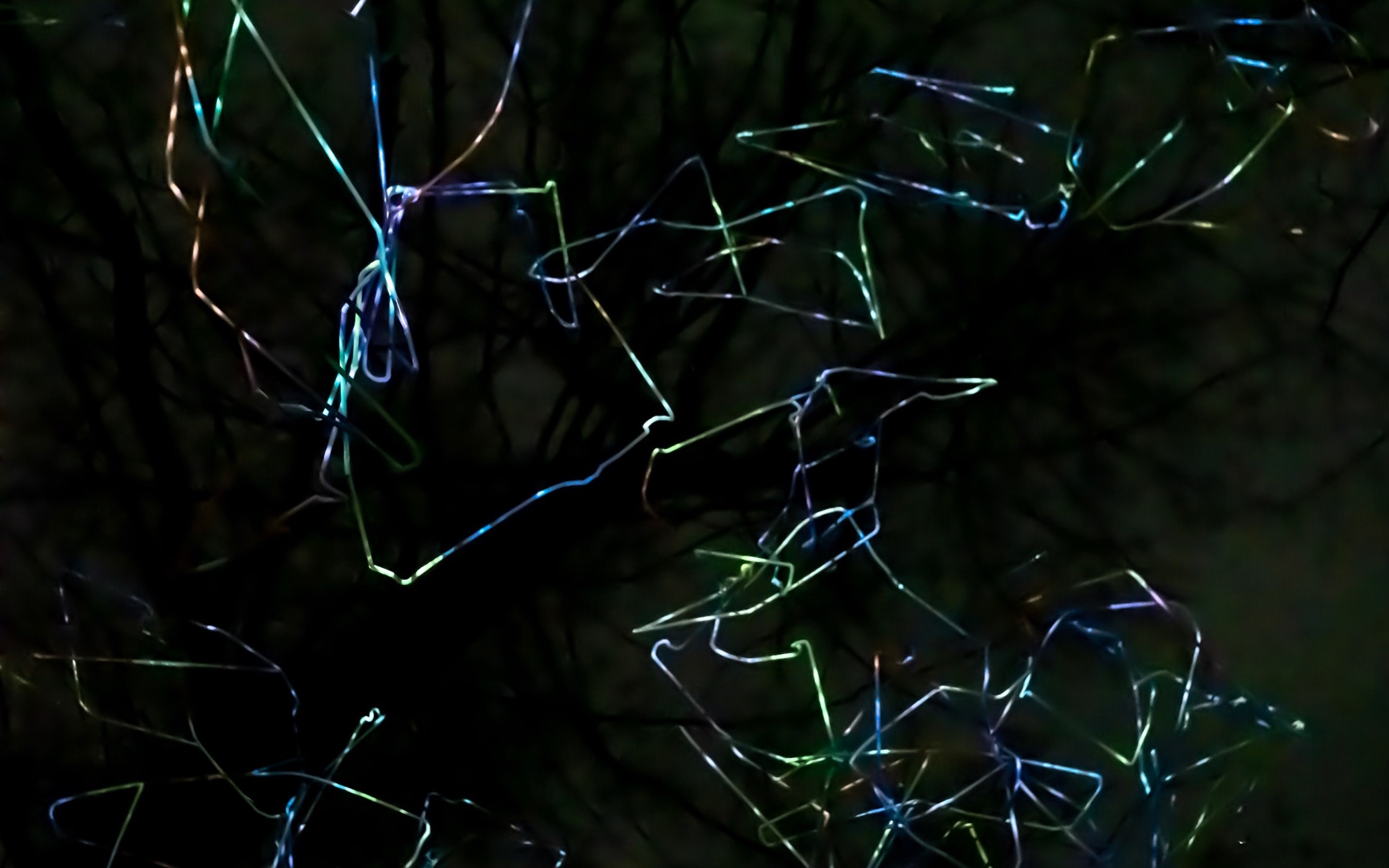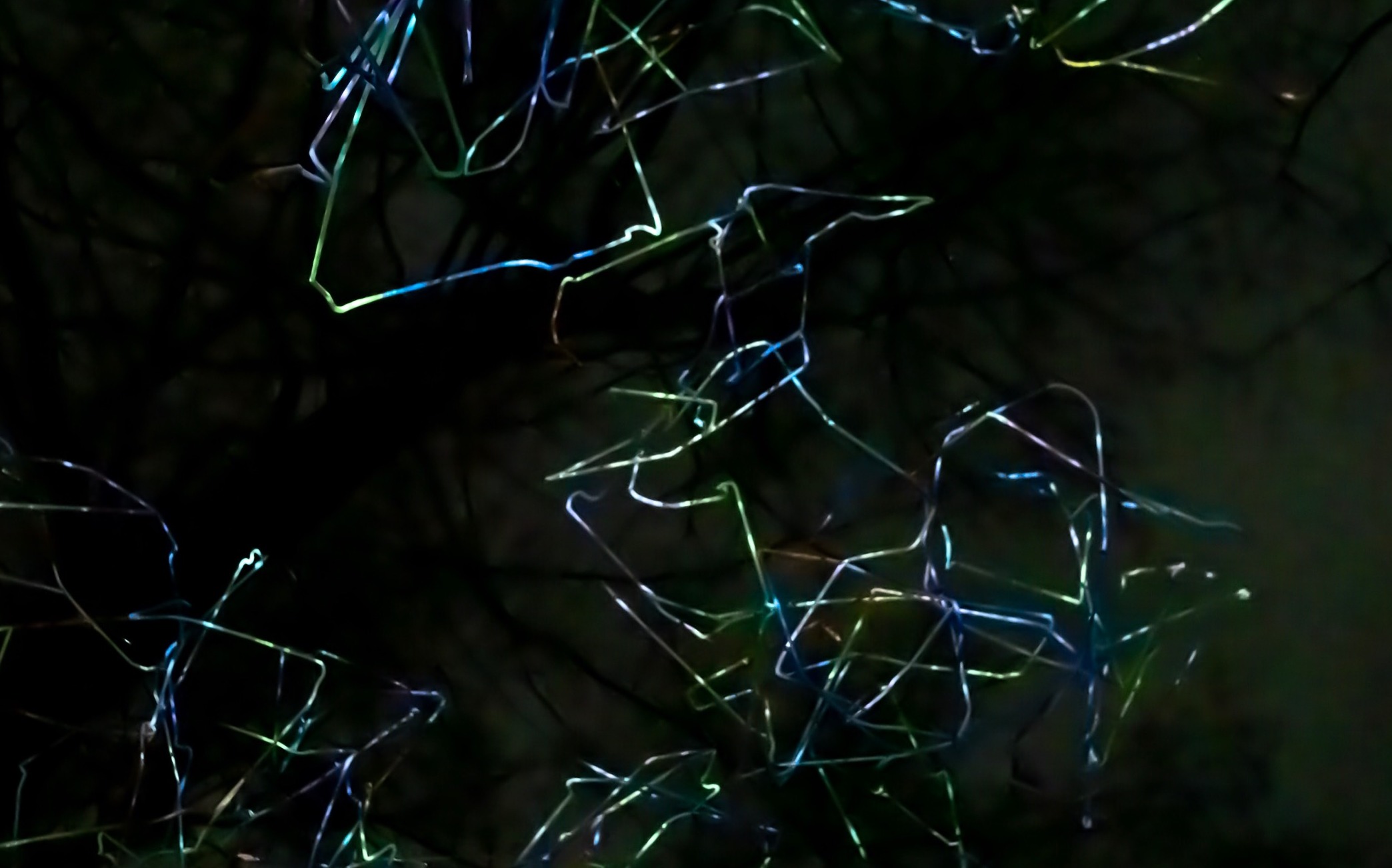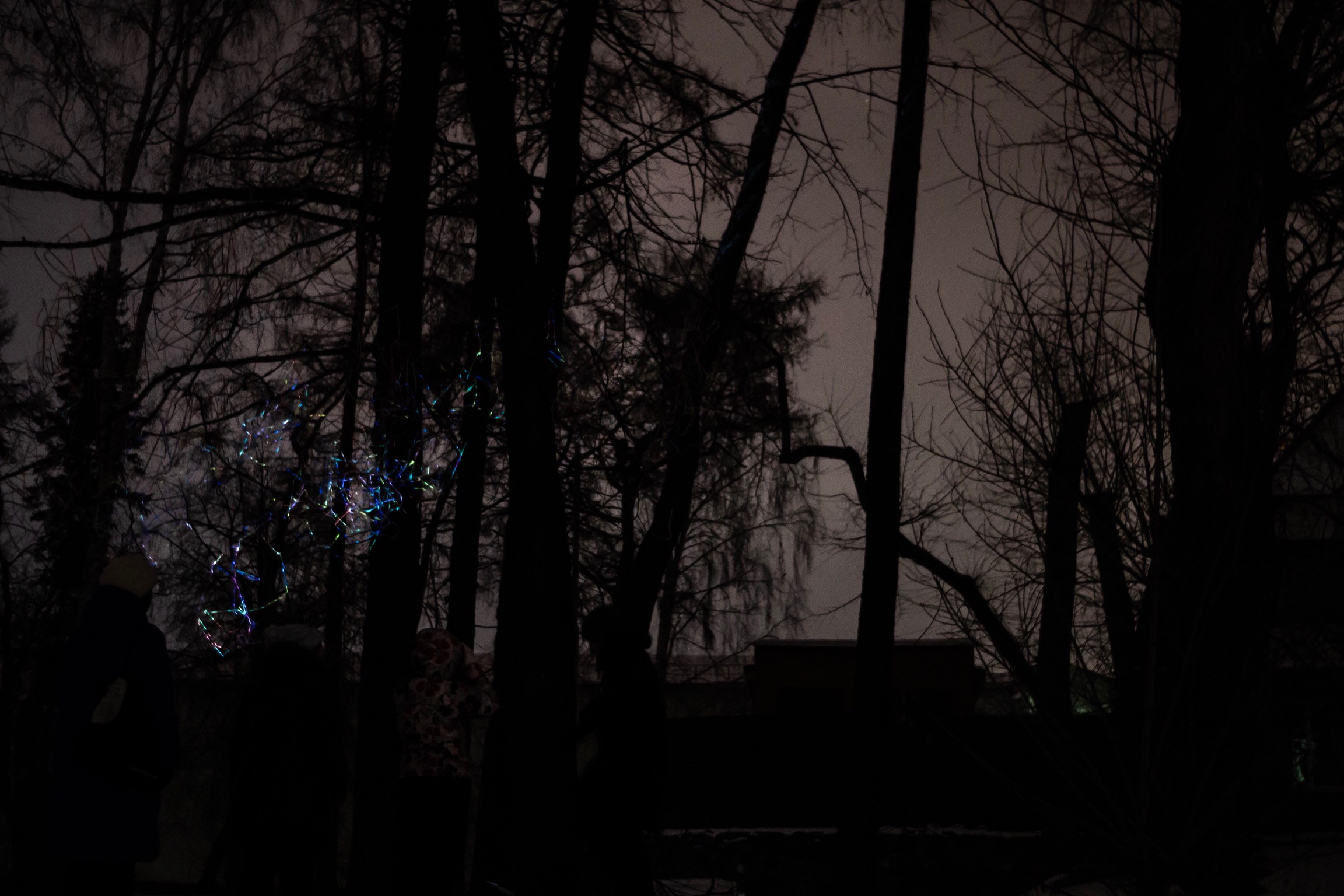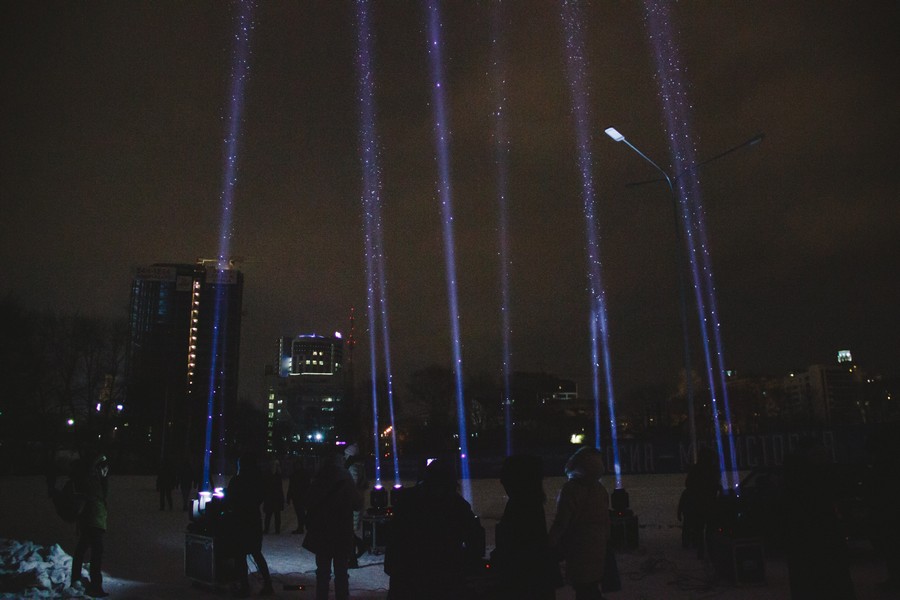_ “We choose the longest night of the year as the perfect time for our light art project”, said founder Evgenia Nikitina when talking about NE TEMNO, the international light art project that takes place in Yekaterinburg.ru. Designed to be a night-time event, all artworks on display use natural and artificial light as material, tool or medium to draw or to paint, to form and to build, to reflect or to project.
Max Sudhues + Johanna Thompson. NE TEMNO Yekaterinburg 2018. Photos: Tomasz Freda.
Local, national and international artists from Europe and North-Africa were participating in the art-in-public-space project. In 2018, NE TEMNO has become a tradition and 1000s of visitors followed the map to find the sites of the 7th edition that are spread across the city’s center. “The five months of winter are a long period when there are almost no cultural activities in public space although we all have to go out every day. NE TEMNO is a good counterpart not to be stuck in the darkness of our winter months.”, explained Evgenia Nikitina. The entire art trail is almost 8 km long and temperatures are down below zero, the second night even colder than the first with temperatures around -20°C. The audience is experienced and well prepared for a walk, but for the artists working outside projects in the winters faced outstanding challenges. Mind and fingers were not working accurately, materials changed their behaviors and projectors stopped working if not housed properly. Even local volunteers left due to the harsh environment. Nevertheless, for the opening, there was almost everything working. Due to an intensive social media and press work, 1000s of visitors were keen to see what had been developed for NE TEMNO 2018.
“Transformation” by Irina and Stas is one of my favourite works in 2018”, producer Sonja Sol was excited. Irina (*1989) and Stanislav (*1989) Shminke, both local, are participating for the second time in NE TEMNO: “This time we are developing… not only an object of art, but also a useful tool to warm the audience. We believe that art should be simple, understandable and accessible, and unobtrusively interactive. Our objects encourage interaction but do not force. We use modern technologies: neural networks, laser engraving, milling, water-jet cutting. Trusting the whole craft part to the programmable machines, we only keep the creativity.” They chose to work with the archaic, sociocultural motive of a fireplace. They built a metal barrel to burn wood inside – the perfect meeting point for a nighttime walk in the cold. Typo-graphic perforations of the barrel displayed the following text: “you are reading this text on the barrel because your mind cannot ignore the written word and here the letters captured your attention and unwittingly you already walk around the barrel in circles and you probably want to know what the meaning of this the inscriptions and its meaning is that you are now part of the transfer plan and right now you are transforming from a mere observer into a participant because we have detained you here by the fire where it is warm, and in order to keep your attention even more spectacular we wrote this text in circle and now for those who look from the outside you’re not just an observer and the person who goes around barrels and together with the other constituents of the composition we are “people who go around in circles barrels”.
Please leave a review. NE TEMNO Yekaterinburg 2018. Photos: Tayana Douksha.
Classic neon writing in white has been used by the anonymous author “Please leave a review”. The intervention in public space denotes the interplay of an artwork as a statement and its review as a continuous communication process between the author and the audience. Since more than 100 years neon lighting has been a popular fixture in outdoor advertising and until now, neon lighting is still used for info and signage in public space. The intervention referred to these standards of use and function of the material. Quotes from visitors’ feedbacks of the Metenkov’s House, the Museum of Photography, were selected and reprodcued in neon. They were placed on the balcony to become art themselves and to spark further reviews. The chosen line translates to English “sometimes it works, sometimes (not)”, with the “not” in an on-off-modus.
Sergey Laushkin. NE TEMNO Yekaterinburg 2018. Photos: Tayana Douksha.
The most experienced of the participating artists was local Sergey Laushkin (*1953). He has been contributing to every edition of NE TEMNO. Mainly working as a painter, he has some works that encompass artificial light as a main material. This year’s work is a homage to “The Parable of the Blind” by Pieter Brueghel, completed in 1568, 550 years ago. It depicts six men with visual impairments sharing walking sticks at the moment when their leader stumbles into a ditch. The motif refers to a Christian parable that can be found the new testament quoting Jesus with “If a blind man leads a blind man, both will fall into a pit”. Laushkin transferred the scene into the 21st Century and made the six main figures in the Brueghel’s work re-appear in man-size and as black silhouettes set in public space. Along a path bordered by the river on one side and the city’s skyline on the other, the choice of the site refers to the scenery of the painting. It became a walk-in scene. Laushkin replaced the blindmen’s sticks in the painting by white fluorescent tubes. It induces associations to the “Shadow Processions” by South-African William Kentridge (*1955), depicting haunting processions of black puppet-like figures made from cardboard cutouts. The figures, hunched and crippled, hauling their belongings on their backs as if in an exodus. By both, Kentridge and Laushkin, light and shadow as artistic material and metaphor are replayed to comment on a moment of contemporary history.
Strings of LEDs were the material for the kinetic installation “Second Nature” by the artists’ collective “Endless Attractions Museum”. Their works refer to the contemporary mindset that treats technical and digital interaction as ingrained in human behavior that it takes place almost automatic and without conscious thought, often even described as “natural”. Nested in a snow-covered open space, they build a sandbox, filled it with artificial plants and illuminated it with strings of commercial Christmas lights in shades of green. It was padded with a digitally controlled, mechanical structure to keep the display in constant motion, clearly staged as a metaphoric comment on ongoing digitization and artificialization. In analogue childhoods as well as in computer security a sandbox describes a defined and isolated area within which each measure has no effect on the external environment. Unclear stayed if they are commenting on the megatrend of intertwining human and artificial resources only or if the denote the impact on contemporary art in present Russian society, too.
Anastasia Krokhaleva (*1994) and Denis Perevalov (*1979) did their first light-based installation for NE TEMNO 2014 and have contributed on a regular base to the annual exhibition project. “We have been participating in NE TEMNO for several years in a row… We work with sound, virtual reality, artificial intelligence and interactive formats but light remains one of the key mediums for us. We not only encompass light in our artworks, but we study the history of the birth and development of Russian and foreign light art, we research and lecture on it.” Max Sudhues commented: “I am excited to witness the development of some local artists that are part of NE TEMNO for some years like Anastasia and Denis as well as Sergey Laushkin or Maria / Masha Plaksina. They adopted light as a material into their artistic approaches and came up with something very new. It is one of the reasons why we need long-term exchanges. If we want to develop together, we need to share time, ideas and discussions, and different settings.”
Anna Rosa Rupp. NE TEMNO Yekaterinburg 2018. Photos: Tomasz Freda.
“It was my first time in Russia and I am grateful that I got a lively insight into Russian cultural life, I was not invited “just” to be a tourist”, said Anna Rosa Rupp (*1990) who was hosted in the Museum of Architecture and Design. “And I was very happy with the proposal of the site”. She is working with analogue prints and their digital equivalents. By translating the manual movements of the printing process into digital animation, she generates environments in which the interplay of the build architecture and the projected visuals engenders a performative process of projection and reflection, distortion and deviation. “Working on my prints is like a research process, I do something and see what it does. And only when I sense a resonance to what I see I know what I was looking for. In the same way, I work with places I visit with my prints. I apply what I have and look for its echoes. This is what I offer to the audience and as well, hoping for a feedback process. Other than in Hildesheim or Tunis and may be due to my missing language skills, I found it not easy to find this mirror of resonance with the audience, but I enjoyed the way we shared time and work among the visiting artists.”
Elena Vertikova. NE TEMNO Yekaterinburg 2018. Photos: Tomasz Freda.
“For me”, agreed Elene Vertikova, “NE TEMNO was a good opportunity to see my work in a different environment and explore how it can adapt. Each festival has its own atmosphere, its own conditions and somehow nature. It is very interesting and inspiring and from every place, we take something to the next. And we learn how to be better prepared for future invitations. … With NE TEMNO, I achieved something new and at the same time I got to know what the next steps for me should be.” An empty restaurant provided the space for the three projections works by Pantaleo Musaro (*1960), Alexey Shchigalev (*1989) and Elena Vertikova (*1984). Pantaleo Musaro was working with a video projection on water, Alexander Shchigalev generated a shadow-play by a kinetic mesh installation and Elena Vertikova worked with analogue projections for abstract color compositions. “For me” _ said Elena Vertikova _ “NE TEMNO is my first experience in a Russian art festival”. Born in Siberia, she is living in Gdansk.pl with her husband Tomasz Freda who does all the documentation of her work. “We were very happy about the invitation and thought that it is a great opportunity to get acquainted with the cultural environment of Yekaterinburg, with the way artists work in the Urals, what inspires them, what techniques and forms of expression they use.” For her, 2018 has been very successful. Based on her main artistic focus on painting, she took part in LIGHT AS A CREATIVE TOOL, a series of workshops and lectures, curated by Robert Sochacki and Wera Morawiev at the Gdansk Art Academy in May 2018. She experimented with replacing pigments by light and brushes by optical devices and developed a way to paint with light. For NE TEMNO, she responded to the found space and worked with metal plates, water and color gels to exploit their optical properties in interaction with lenses and LEDs. Her murals were among the best site-specific interventions of the project. In addition, she premiered a mechanical image generator based on the same principles. The small screen device shown in large-dark space was among audiences’ favorites. “The audience, despite the very cold weather, came with interest. They were open to conversations and were quite keen to know more about the use of light as artistic material. The mix of joy and curiosity was a great experience for us. And we profited from the fact that we both speak fluent Russian.”
GRAN Workshop. NE TEMNO Yekaterinburg 2018. Photo: Tayana Douksha.
In one of the backyards, the audience found a luminescent geometric structure which choreographed an interplay of transparency and reflection by Pavel Vasilyev (*1993), Alexander Gedz (*1990) and Igor Khabarov (*1989) titled “Closed Infinity”. Metal structures, LED tubes and mirror foil are used to form a polyhedron known as well as “Platonic solid”. These were made of a choice of congruent faces forming a 3d shape and explore the interplay of material and shape, light and optical properties. In the near-by studio, the artists explained the idea and the process of development. They showed some prototypes and offered a cup of tea. “We want to make use of the opportunity and draw your attention to the space around our property. This an old building of the Ekaterinburg gold mining laboratory, which is unfortunately in a deplorable condition. We would like the city administration to pay special attention to this place, as a creative cluster unique for the city has been formed here for a long time.”
Max Sudhues. NE TEMNO Yekaterinburg 2018. Photos: Tomasz Freda.
As well the work of Max Sudhues (*1977) at Nurov Garden wanted to draw attention to the site with a mix of analogue and digital projections. ”The place is named after a former mayor of Yekaterinburg. The garden is used for cultural activities run by a group of volunteers who try to prevent that historic sites disappear from the city’s map. During my preparing visits I found out that it is rather a parking lot than a garden. With the projections, I tried to bring back a more garden-like and dreamy feeling to the site.” Maybe Max Sudhues approach can be described quoting German artist Anselm Kiefer (*1954) whose entire body of work targets the interplay of past and present, of unsolved issues and unrealized potentials, “I think there is no innocent landscape. There is so much what happened on landscapes, on countries, on states, that you can find everywhere the … traces. … I discover the traces in the landscapes. The landscape is for me not only beautiful for itself. It’s a container of traces.”_1 Max Sudhues treats the site and its contexts as his raw material, aware that whatever we put into a place will be mingled with whatever was there before. Images that have been taken onsite were printed on foils to be used on overhead projectors. They were combined with natural materials found onsite for two parts of the intervention. Two videos were built on images of mountains that had been printed on paper, manually manipulated, and dissolved in water. The third one referred to a campfire. Each of the projections interfered with a selected aspect of the site. And the audience responded with great sensitivity: “Alchemy is not to make gold, the real alchemist is not interested in material things but in transubstantiation, in transforming the spirit. It’s a spiritual thing more than a material thing. An alchemist puts the phenomena of the world in another context”_2, describes it Anselm Kiefer.
Aziz Aissaoui. NE TEMNO Yekaterinburg 2018. Photos: Aziz Aissaoui, Tomasz Freda.
Transformation of found materials is of importance for the artistic approach of Tunisian Aziz Aissaoui. Weiner Garden was the place of choice for him, working with plastic straws he collected from bars in Tunisia, Germany and Russia. “Luckily, they are on their way to disappear from our life because they are part of the damage, we do the ocean. By 2050, there will be more plastic in the ocean than fish if we don’t change our use of plastic items. Plastic straws are among the useless things we can easily give up. So hopefully, soon, plastic straws will be an item of the past.” Aziz Aissaoui started to work on straws as a building material to address the environmental need of banning them. He built light-weight structures of plastic straws and hung them between trees in the small park. They were gently moved by the wind. From three sources, a Tunisian poem written in white letters was projected onto the kinetic intervention. The interplay of site, mobiles and projections engendered the impression as if the park was the habitat of a swarm of fireflies. The poetic atmosphere was especially striking in front of the backdrop of several radiant high-rises in the distant. It was one of the sites where the curatorial focus on communication and interaction led to a new sensory experience in a well-known space.
Evgeny Kormiltsev + Brian D. Mckenna. NE TEMNO Yekaterinburg 2018. Documentation: Evgeny Kormiltsev.
For the immersive audio-visual performance “Snow Bees” local Evgeniy Kormiltsev and Brian D. Mckenna from Amsterdam.nl made use of the projection dome of the planetarium to stage an improvisation. Although it was a recorded version, the spark of the seamless interaction between the audio and the visual sphere was very present. The artists shared a residency in 2018 in Yekaterinburg to explore the intersections of art and technology, image and sound, viewing and hearing as well as the process of translating from one to the other medium. They are improvising with audio-visual abstracts, repetitive structures and hypnotic choreographies. The chemistry of sensory reflexes, perception (over) stimulation and mind control are quite playful and at the same time opens a framework to reflect on how we engender imageries and world view.
“NE TEMNO is a very insightful and poetic moment and it adds knowledge and narratives to my life _ it is as if we could travel back in time and rediscover the world with the eyes and the heart of our childhoods.”, looking back on the 7th edition, Sonja Sol reviews the challenges of production: “Sometimes the very simple things are the most problematic. Where ever we go, we have to find an access to electricity, and it is not easy to find the ones that are not too lazy to help us. It would be great to find more accomplices to help NE TEMNO grow.” NE TEMNO is an alternative display for contemporary art in present Russia. While the conditions of contemporary art in Russia over the past 70 years are not at all clear regarding working and funding, displaying and disseminating, critical debate and theoretical reflection, initiatives like NE TEMNO publish and mediate a wide range of contemporary artistic approaches. By utilizing public space and by reaching large audiences they foster the dialogue of contemporary art and sociocultural and sociopolitical development. By including international exchange and discourse, they engender further gateways for conversation and co-operation instead of being stuck in a convoluted and incomprehensible situation.
NE TEMNO is an artist-and-curator-based initiative. Evgenia Nikitina (*1960) is the curator, she associates artists and sites, professionals and volunteers for an exhibition of contemporary art in public space. Looking back, she reflects: “Really, 7 years ago we did that for ourselves and friends. The main goal was not to spend time at home or shopping malls but to have a good reason to walk and enjoy the city. We didn’t have any city marketing ideas in our minds. And friends were friendly, they came and shared our ideas, and all over a sudden we had a lot of friends. It has been a great development.”
“The very process of organizing the festival is a great pleasure. It is like a boiling pot in which a large number of creatively charged, like-minded people meet”, said Sonja Sol (*1986) who has been the producer in 2016 and 2018. “In these two years, light surprised me. It is an amazing material, it is a sensory experience and it can trigger feelings, it can transform space and time, light is a very symbolic material and it can turn everything inside-out. I am very thankful to Evgenia that she makes us, all the team, part of this art project.”
German artists Max Sudhues has been participating as an artist and co-curator since 2012. He met Evgenia Nikitina as part of an international team of volunteers that were supporting the production of the international exhibition project GLOW in Eindhoven.nl in 2009 and both established a long-term collaboration. Being part of the 7th edition, Max Sudhues said: “Since 2012, I gave workshops and master classes, I was part of the curating process and I did show my art works in various places in the city. It has been a challenging but very inspiring process as well.”
The 2018 edition of NE TEMNO profited from the co-operation with LICHTUNGEN Hildesheim.de, LIGHT AS A CREATIVE TOOL in Gdansk.pl and INTERFERENCE Tunis.tn that extended the range of international contributions. “International networking and participating in various displays, peer-reviews and conferences of the international network of light art projects were very helpful to develop and to promote NE TEMNO over the last eight years”, said Evgenia Nikitina. She is local, initiated the project in 2012 and has been producing it. “I am not educated as a curator, but I function as one. I am happy that the NE TEMNO project has been growing and improving over the recent years. This year, for the first time, we received recognizable public funding.”
Pavel Vasilyev + Igor Maratkanov. NE TEMNO Yekateringburg 2018. Photo: Tayana Douksha.
Yekaterinburg has about 1,4 million inhabitants and stretches across 495 km². It is situated on the border of Europe and Asia, 1.667 km east of Moscow and 3.375 km west of Irkutsk. Citizens of Yekaterinburg ride the fastest metro in the world. It is only one line, it crosses the city from north to south along 13 km and it can be travelled in 20 minutes. 52 million people yearly make use of it. Its skyline is coined by high-rises, several of them with dynamic LED surfaces. The now-missing tv tower that has been a landmark since 1991 and got demolished this year as part of the urban development measures in preparation for the FIFA World Cup. During NE TEMNO, it was paid a tribute with a large-scale installation by Pavel Vasilyev and Igor Maratkanov. The installation consisted of six pairs of LED-based projectors. Their beams became visible in the slightly foggy and snowy nights. To make use of the specific climate during the exhibition period is a part of the site-specific approach of NE TEMNO. “The festival creates a very special atmosphere and we ask us to be in the very moment. It is an opportunity for us, the team working on it as well as the audience, to leave our usual context and review it as if we are looking at it from another world”, said Sonja Sol.
Several spots along the banks of the Iset became sites of the exhibition project. The river originates from the Urals and bisects the city. It played an important role in the city’s development. The town owes its origin to a metallurgical and metal-working plant which rose on the banks of the river Iset, and by the standards of those days was one of the best, not only in Russia but also in Europe. Nowadays, the river’s banks are green, recreational areas. To include sites that are part of the cultural heritage of the city and that are shared in collective memory is part of the guiding curatorial interests. Evgenia Nikitina said: “Discussing and reflecting the past and its traces in town is part of our idea of how to approach the future.”
Smaller parks that can be found around the town, among them the Popova Park, the Nurov Garden and the Weiner Garden, hosted artworks. They all provide the kind of darkness that artists who work with physical light need as their backdrop. “It is not easy to find dark spaces in the city’s center and it would be great if the city’s administration will support us in the future by turning off street lights for the short time of our festival. We know from our international partners that is possible.” _ wishes Sonja Sol. Most parts of town are flood lighted and suffer from severe sky glow. By the choice of sites, the exhibition project generates a framework for critical debate on the city’s lighting design, including its sociocultural and ecological impacts. Light pollution not only threatens astronomy but also disrupts wildlife and affects human health. Worldwide professionals of sciences and arts are engaged to shift lighting practice to a reflected use of light. NE TEMNO is one of the international art projects that encompasses the policies of the international movement. “In the future, we might have to leave the city’s center to find more dark environments with properties and qualities that are of interest for artists. “_ reflects Evgenia Nikitina, “it would be great to find further support by proprietors, administrations and companies for our temporary interventions. The good things about working with light – we can change a lot and after it, the experience stays in the collective memory but the sites, we can leave without a trace.”
Yekaterinburg is a rich cultural life with around 50 museums, 50 libraries, several cultural centers, theaters and a philharmonic hall, a circus and a focus on film production. It is home of 21 universities and colleges as well as 12 research institutes. In 2018, the Art Academy Yekaterinburg, the Museum of Architecture and Design, the Museum of Photography in the Metenkov’s House and the Museum of The City’s History hosted art interventions. The cinema center opened the planetarium for an audio-visual performance. In addition, urban vacancies, shops windows and local bars made space for artistic interventions. Temporary art events like the URAL INDUSTRIAL BIENNIAL OF CONTEMPORARY ART in Yekaterinburg (since 2011) and NE TEMNO provide was is missing in the cultural tissue of town: ephemeral artforms, light and media-based artistic approaches, art-in-public-space and art-in-context formats, transdisciplinary debates and residencies for further site-and context-specific developments. The international light art projects VISUALIA in Pula.kr, INTERFERENCE Tunis.tn and SVETLOBNA GVERILA in Ljubljana.si engage successfully in similar concepts. “SVETLOBNA GVERILA started in 2008 and from the beginning, we tried to strengthen our local network through notorious co-operation. By now, we are very free in the choice of sites and can respond to almost all artists’ interests.” _ said Katerina Mirovic, the local founder and curator. “Like-minded projects like NE TEMNO are very interesting partners for future co-operations.”
The Art Academy Yekaterinburg is NE TEMNO’s partner for an accompanying conference program. Reflecting on light and media art in public space was focus of lectures, presentations and roundtables with artists, curators and academics. Scheduled before the exhibition’s display, it was helpful to understand backgrounds and contexts of some of the participating artists as well as the ongoing discussions on contemporary art in Russia. Recent years have seen a boom in Russia’s contemporary art scene. In addition to renowned art institutions, a contemporary art explosion is sweeping an entire country with art galleries and workshops opening, street art moving into the spotlights and festivals. As of 2018, Russia recognizes by law contemporary art as art. Previously, valuable works of art created fewer than 50 years ago were officially treated as “luxury goods” and subject to 30% import dues. This changed on January 29, 2018 with a new law that is part of a radical revision of Russian art import-export regulations aimed at opening the Russian art scene to the world. There is a significant interest for more international networking and co-operation between artists and curators, academies and new displays, art collectors and art markets. NE TEMNO is one of the frameworks that is an open space not only for young artists and offers new gateways. NE TEMNO provides a new display for contemporary art away from institutional settings and funding structures. “And it is not only conceptual, it is personal as well”, said Sonja Sol, “I am touched when I see how people gather to walk the festival’s trail, and when watching the works, how personal these experiences are. It seems to me that all I do is for the sake of these moments of self-study and unity.”
“I believe in the urgent importance of cultural exchange and the support initiatives of artists and curators. We need productive encounters of intelligent and interesting people to see things from more than one perspective and discuss how to do things better _ in our art, in our lives and in the world.”, said Max Sudhues. For him, the active and porous texture of the international art community has a share in his long-term dedication to NE TEMNO: “As artists and curators we know how to understand different approaches and positions, we are experienced in discussions and processes that are nourished from different sources and perspectives. With all our extremes, we live a democratic culture when we work together. … And as artists, we need these encounters like NE TEMNO, the exchange of thoughts, reviews of what we see and debates of what we want to do and how we want to live.“
Evgenia Nikitina added “… yes, it is very important to generate this kind of opportunities on a regular base. NE TEMNO 2018 was again a great inspiration and at the same time a call for further activities. We want to improve what we are doing on artistic and curatorial levels as well as on organizational and technical levels. We want to engage more with our large audience and include them in the exchange with artists and curators. Art mediation is a field where we can improve what we are doing. With every experience, I see more clearly what we need and how we can make it better. It would be great to find support for the entire system of the project.” Over the last seven years, NE TEMNO gathered knowledge and network to feed a solid framework for an international recognized project with strong local roots and it generated a large audience for contemporary art.
NE TEMNO’s goal is to create horizontal links, promote regional artists and curators, study the current situation on the ground through a professional dialogue, and create new opportunities for international co-operation, but it comes with challenges as well. Max Sudhues observed: “Maybe due to the greater number of international artists, discussions changed. We had an intense time among the international participants, but we missed the involvement of the locals. I felt a change in the atmosphere, especially regarding the curiosity, openness and hunger for different societal, sexual and ethical models, discussion and deep exchange. A main sign was that almost nobody of the younger generation spoke English anymore – in my eyes this situation was much better a few years ago _ but maybe it is missing experience only.” “Yes”, answered Sonja Sol, “if I am the one to speak for the Russian team, I can sense the obstacles. The first is linked to our idea of hospitality, we like to offer more space and recognition to our beloved guests. And other is, that we feel that we are missing the experience of how to move in an international team. Most of us haven’t been part of international productions and we become shy when we see how natural and warm the others are with each other. And yes, English is an issue. We miss opportunities to practice, but that is what we want to change. We young Russians we want to be part of this international circuit and we’ll be happy to add to it.”
Although NE TEMNO claims to foster young artists which usually refers to life time, the age of the participating artists ranges from 18 to 65 years. The diversity in experience adds in a great way to the poly-perspective approach of the entire project. The link between life-time and artistic assets is too often a wrong short-cut as is the idea of a quality relation between public exposure and artistic qualities. Staying away from the conventions of the art world that obstruct the view of the ongoing and innovative artistic researches and positions independent from age and institutional success, foster polyvalent, plural contemporary art production.
And why is gender inequality still rife in the visual arts? In 2018, we really shouldn’t need to reiterate such an obvious principle. NE TEMNO contributors were to 50% male, 29% were collectives and 21% were female. The sad fact is, with gender inequality still so prevalent in the contemporary art world, we may need to keep doing so for some time to come. If projects like NE TEMNO want to build momentum for change to overcome structural inequality for female artists, it needs calls and care for greater representation of female artists. In both public and private projects, there is only one way forward. We need more significant opportunities and programming of women artists by all curators, producers and funders.
NE TEMNO 2018 staged 24 artistic approaches, about 70% of them were Russian. Most of them haven’t been seen in international art exhibition projects and festivals. For the future, it would be great to invite more curators and producers from all over the world to intensify the critical debate on light as material, medium and metaphor in contemporary art and to assist local and national artists in communication and dissemination of their work. At the intersection of the local and global spheres, NE TEMNO 2018 shows that Russian artists and curators should have a share in the debate on the dialogue of contemporary art and societal developments, on how cultural heritage and political circumstances define us and on how to address global problems and ongoing trends. They have their unique perspective and their twist on how to share them. They they are a missing voice in the international circuit of light-based art projects and festivals. The next edition of NE TEMNO will take place in December 2019, it will be a very good reason to visit Yekaterinburg.
INTERVIEWS
All interviews by Bettina Pelz from December 20 to 31, 2018.
REFERENCES
1 _ Jim Cuno: Interviewing Anselm Kiefer. On: The Iris. Behind the scenes of the Getty. Published on December 13, 2017. URL http://blogs.getty.edu/iris/audio-interviewing-anselm-kiefer as seen on December 30, 2018.
2 _ Jackie Wullschlager: Interview with Anselm Kiefer, ahead of his Royal Academy show. On: Financial Times Online. Published on September 19, 2014. URL https://www.ft.com/content/4ad87118-3f42-11e4-a861-00144feabdc0 as seen on December 30, 2018.
LINK LIST _ NE TEMNO
NE TEMNO’s Website
NE TEMNO’s Facebook
NE TEMNO’s Instagram
CULTURAL TRANSIT
LINK LIST _ Artists
Aziz Aissaoui
Anna Rosa Rupp
Endless Attractions Museum
GRAN Workshop
Brian D. McKenna
Sergey Laushkin
Pantaleo Musaro
Please leave a review
Irina + Stas Shminke
Max Sudhues
Elena Vertikova
LINK LIST _ Photographer
LINK LIST _ International Network
GLOW Eindhoven
INTERFERENCE Tuins.tn
LICHTUNGEN Hildesheim.de
LIGHT AS A CREATIVE TOOL Gdansk.pl
SVETLOBNA GVERILA Ljubljana.si



